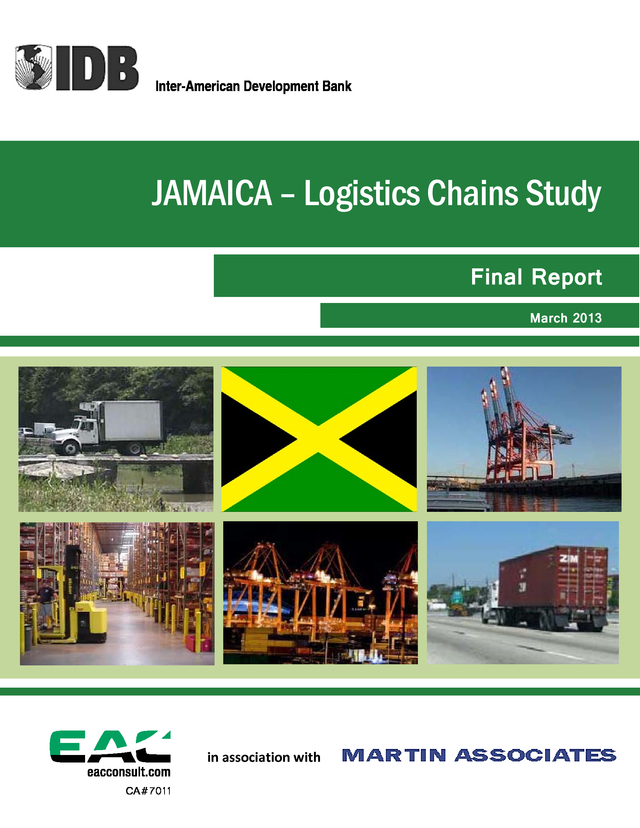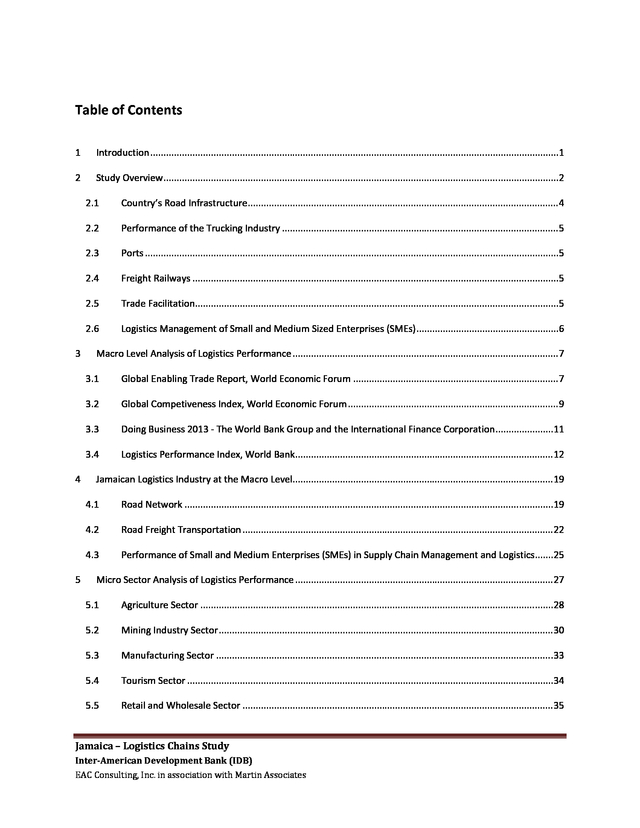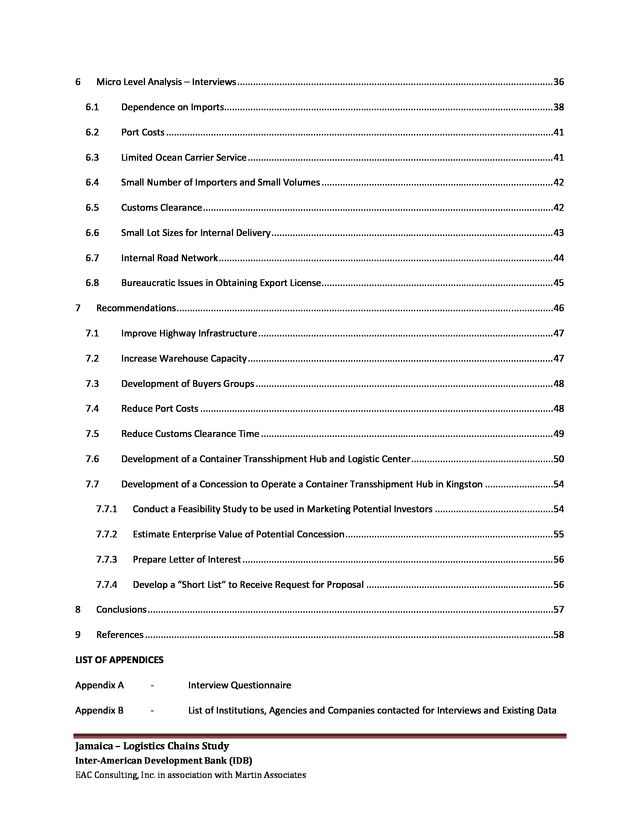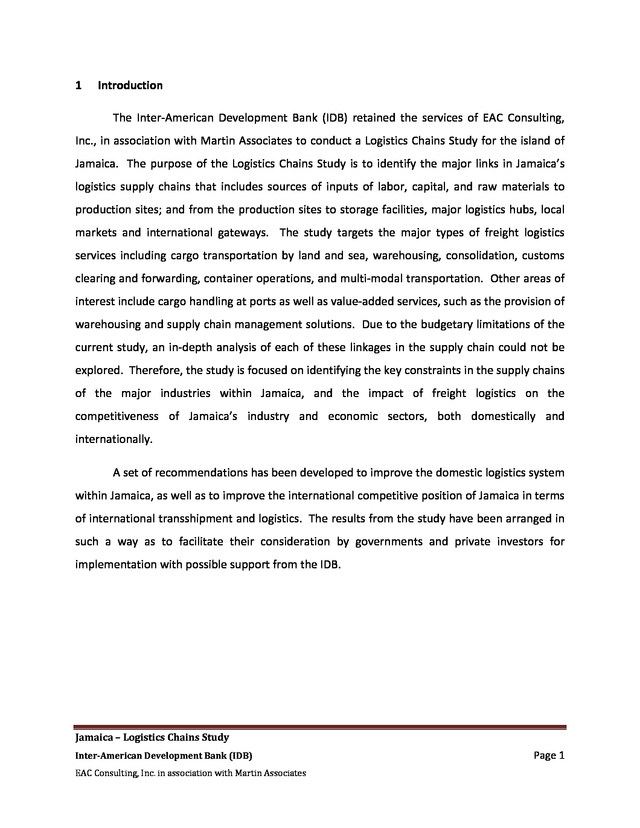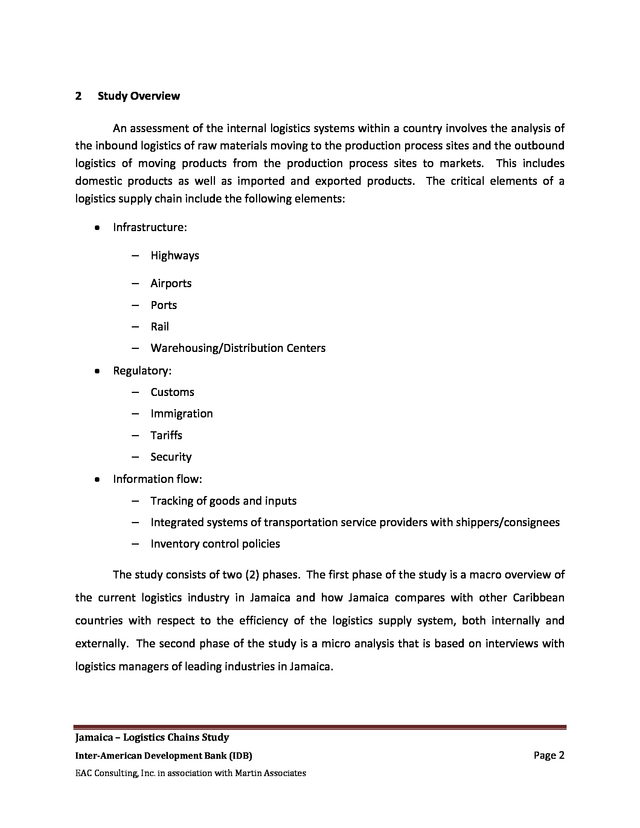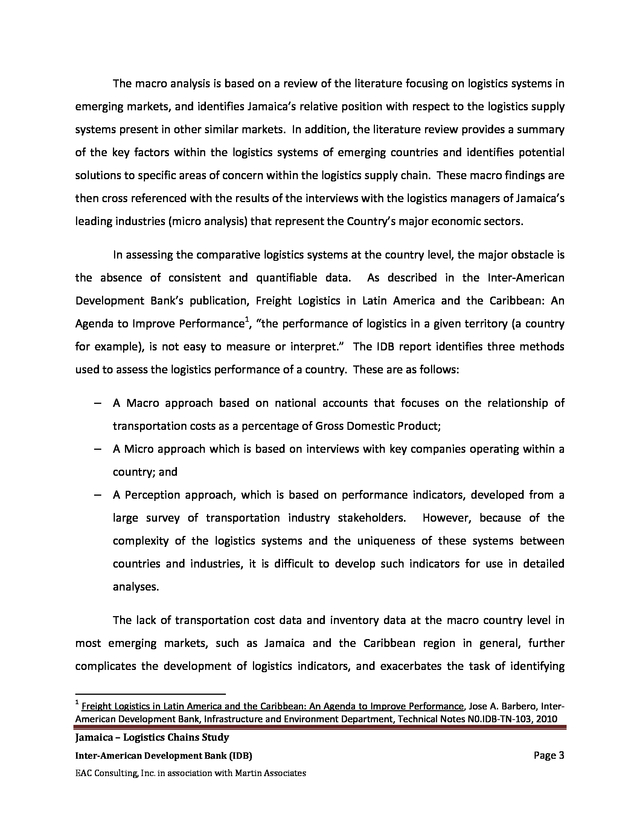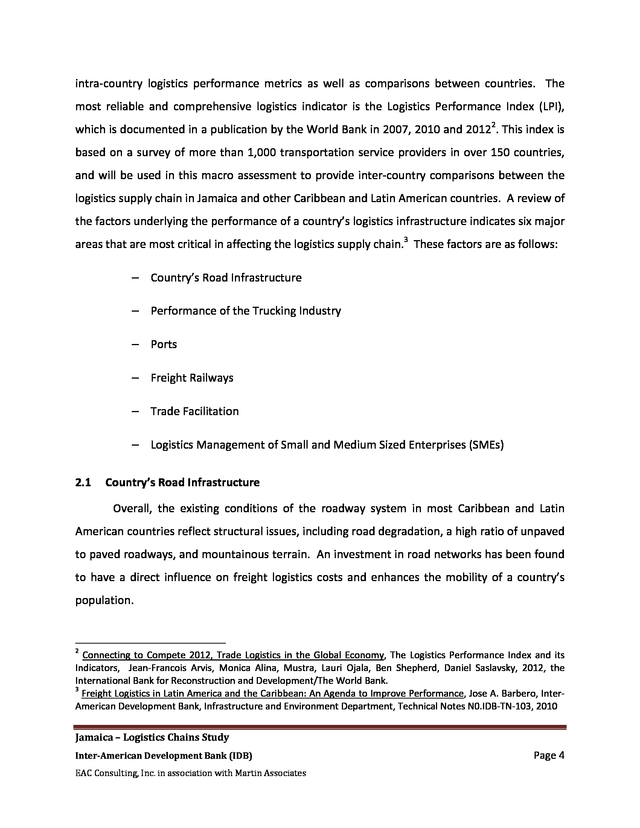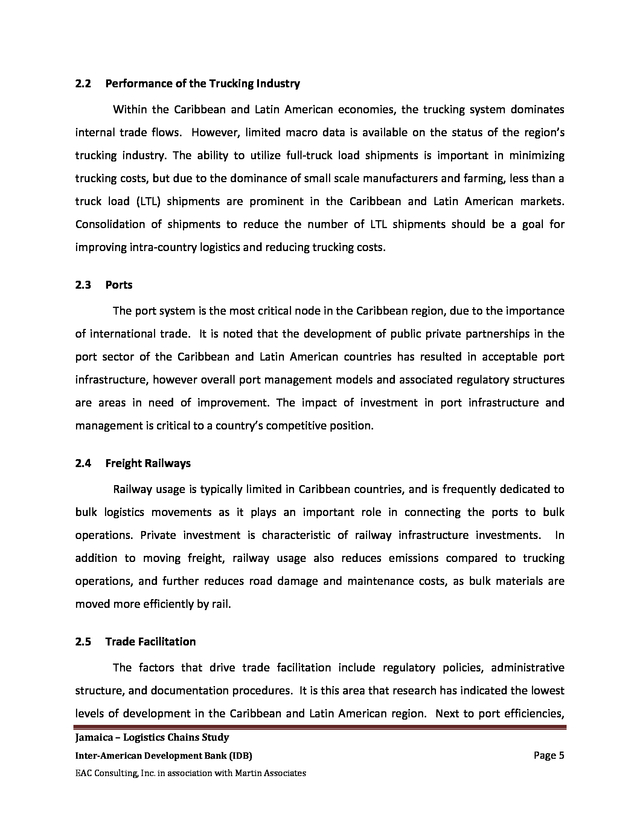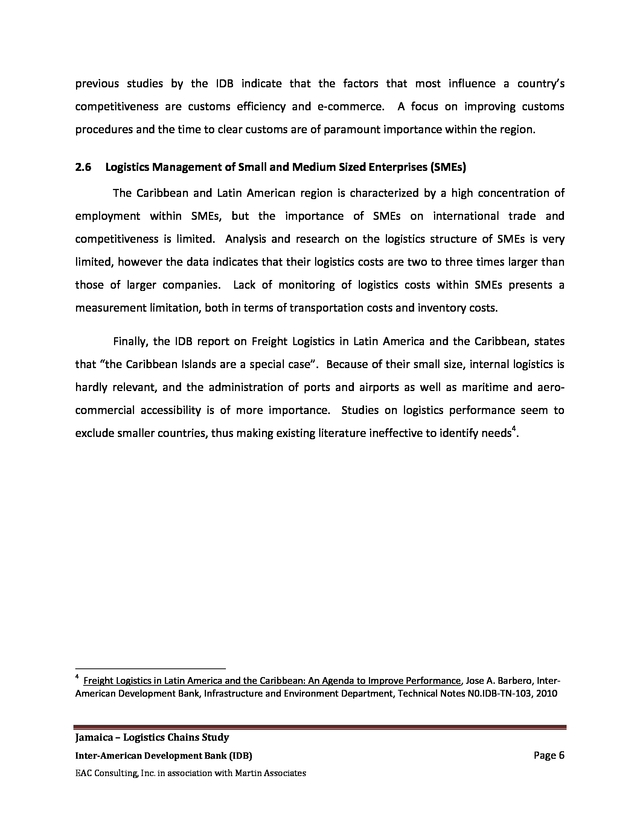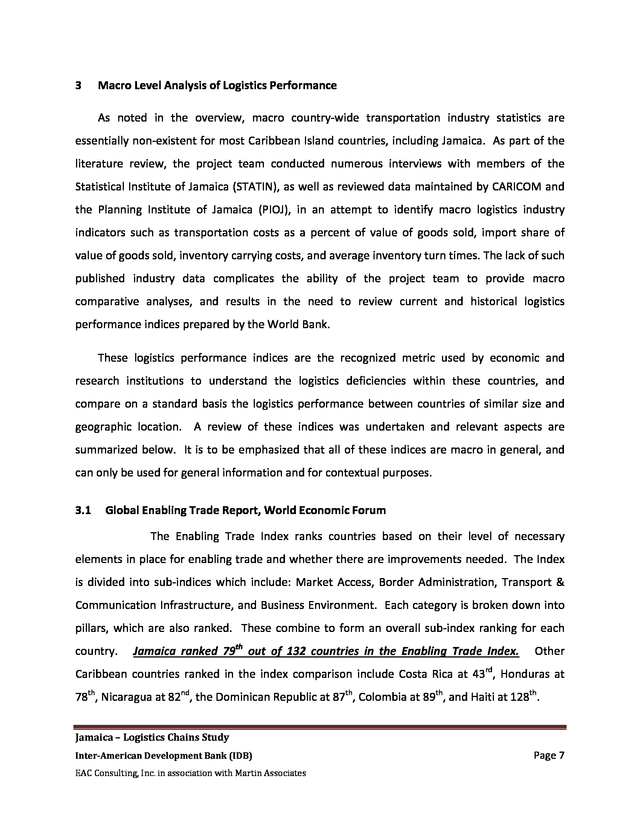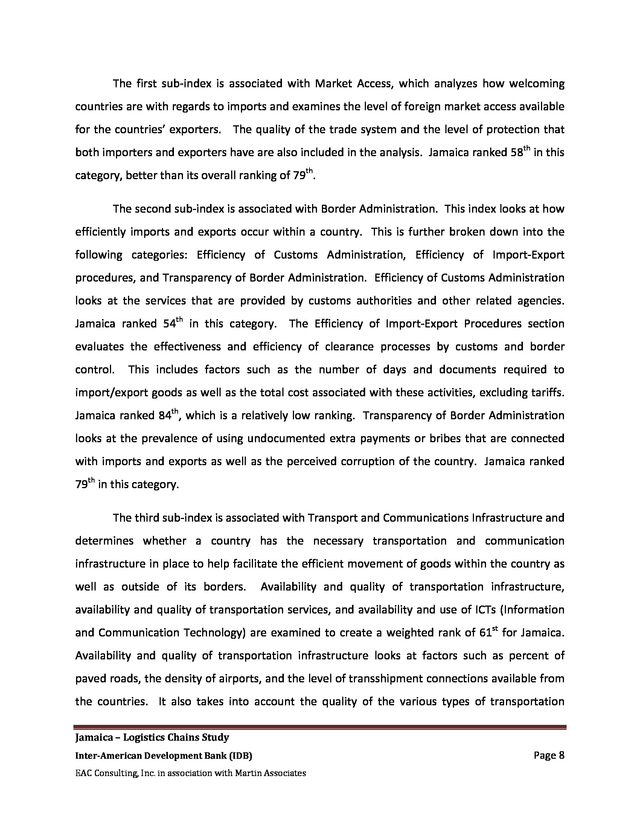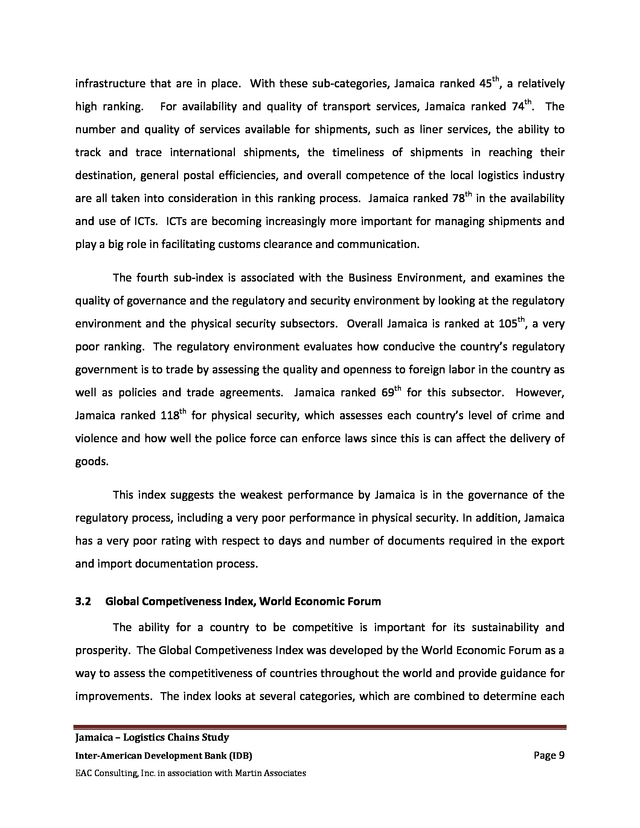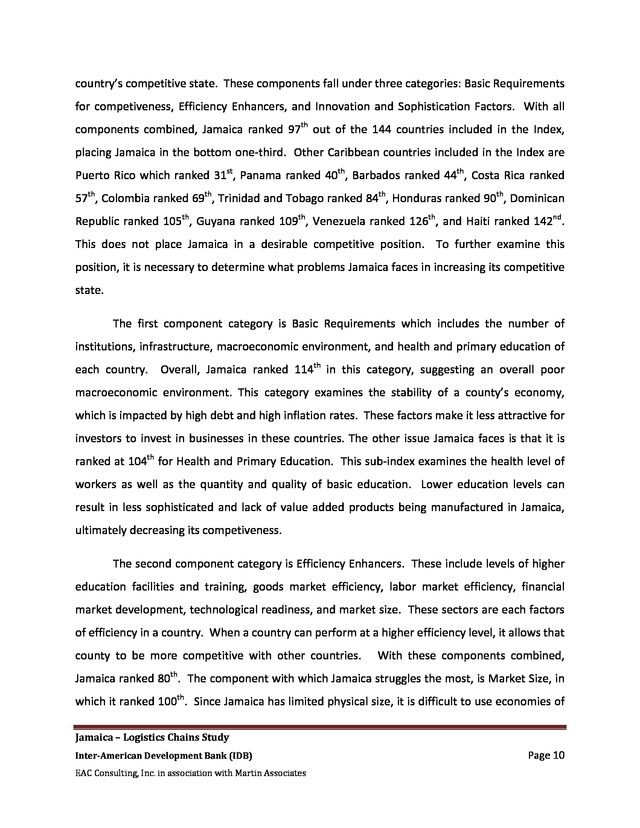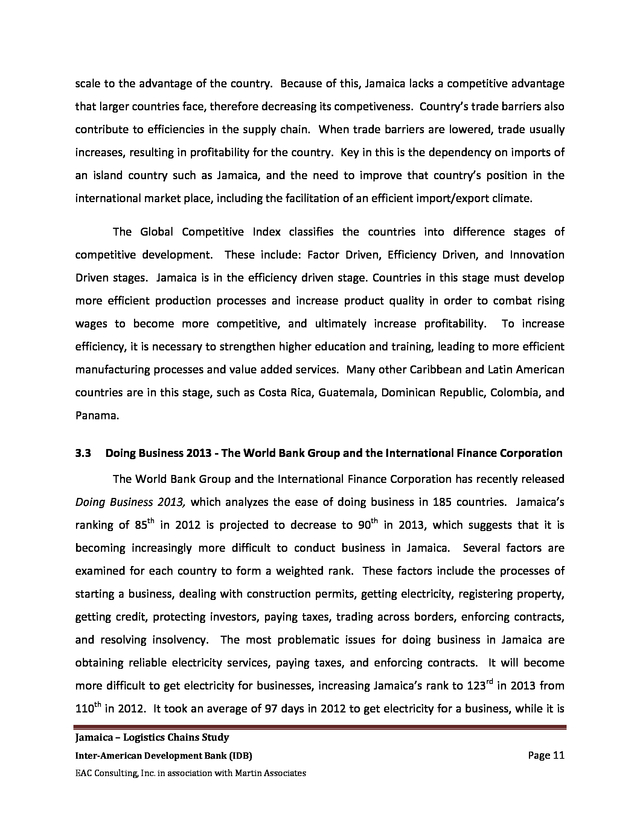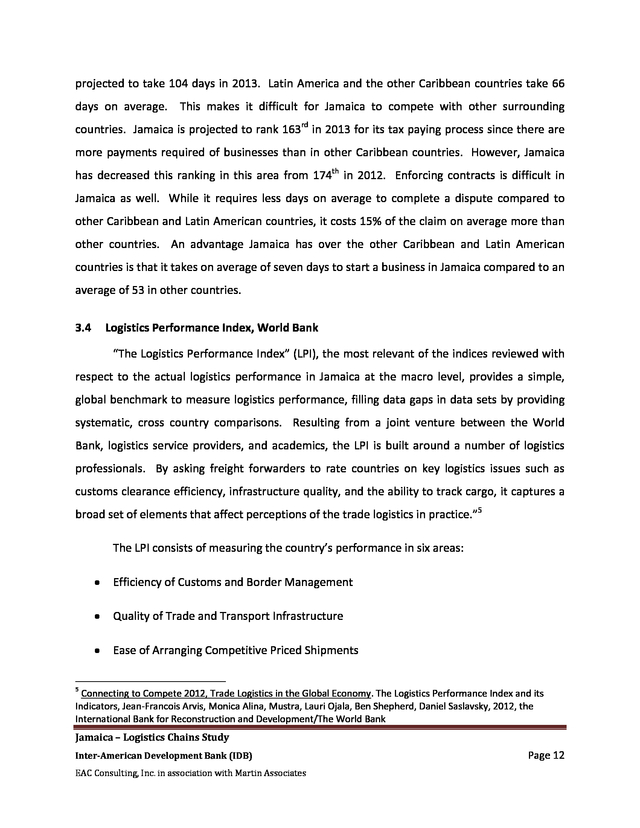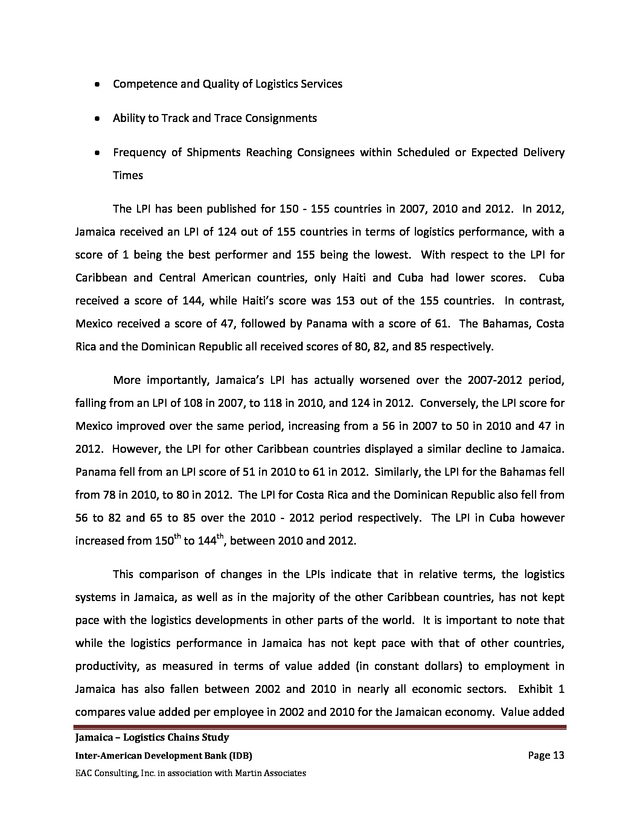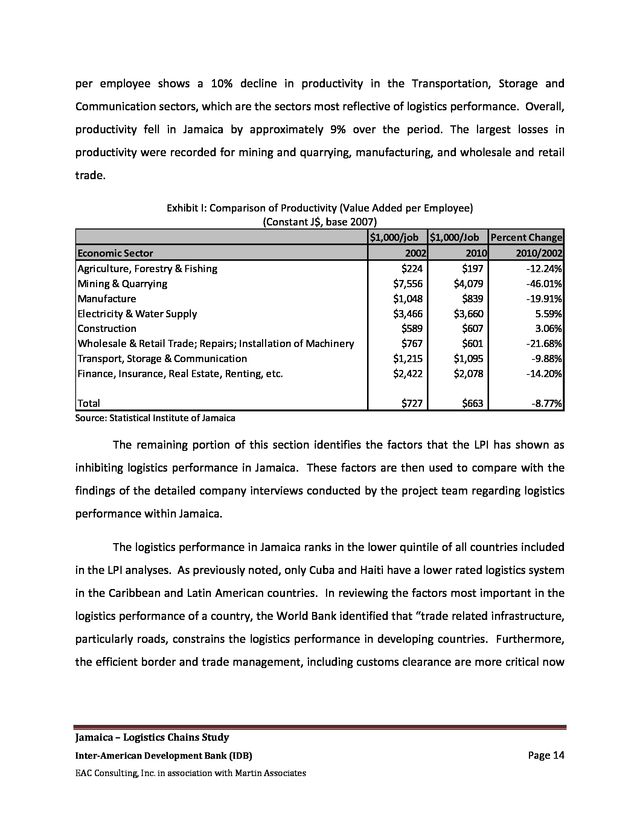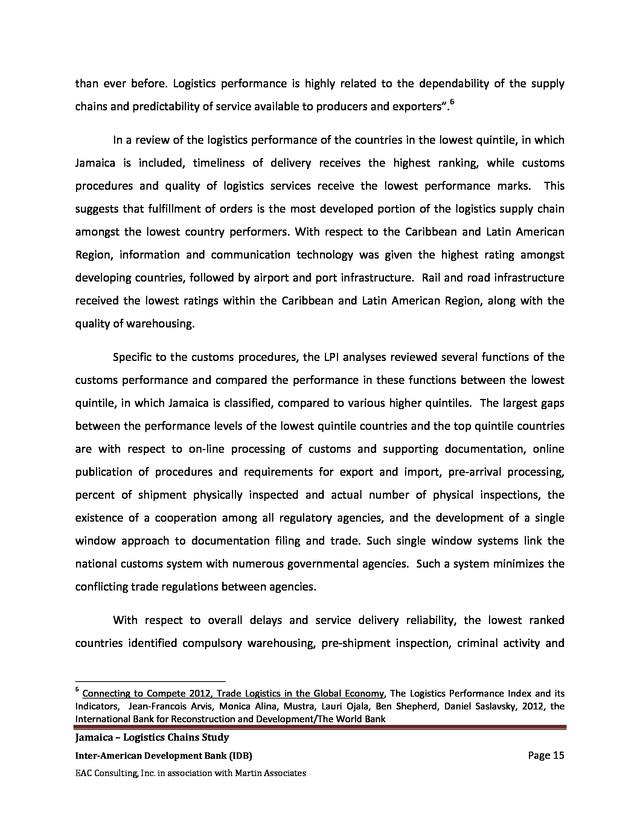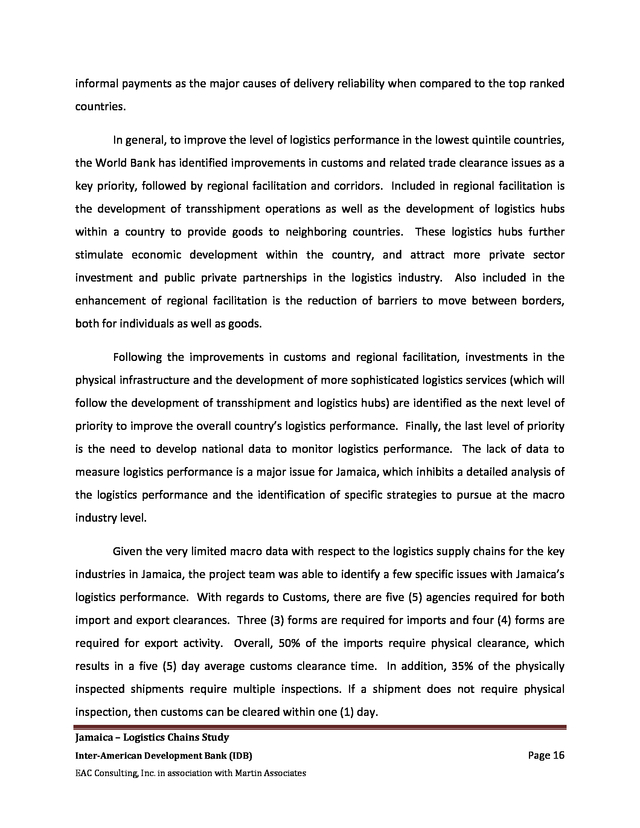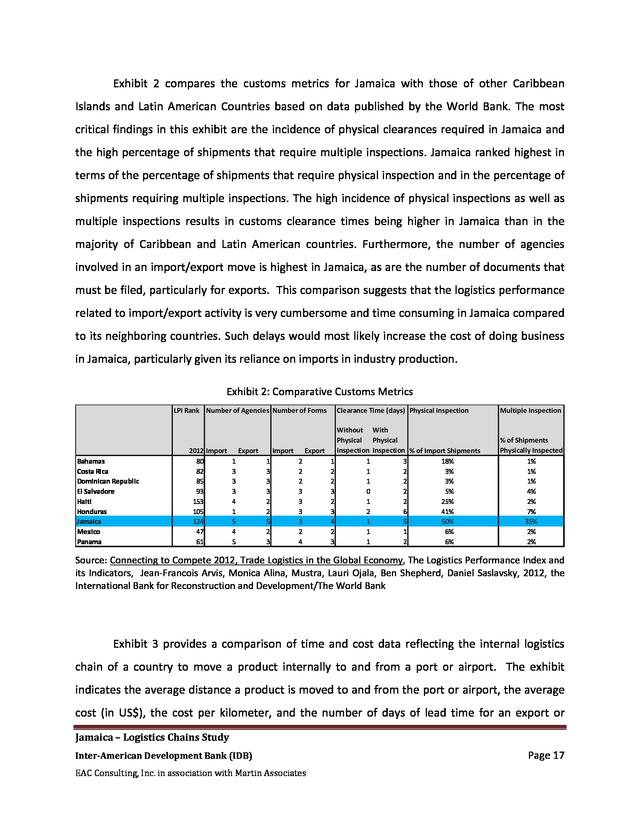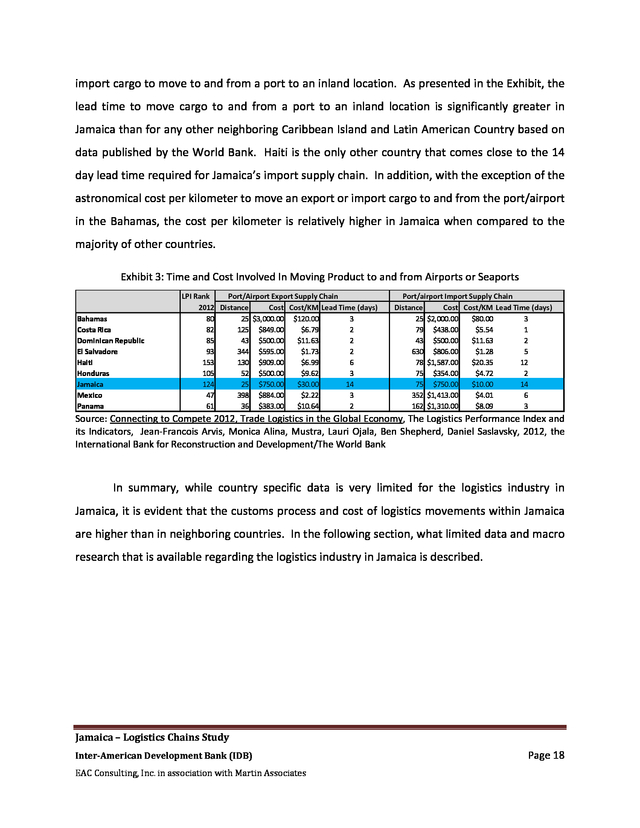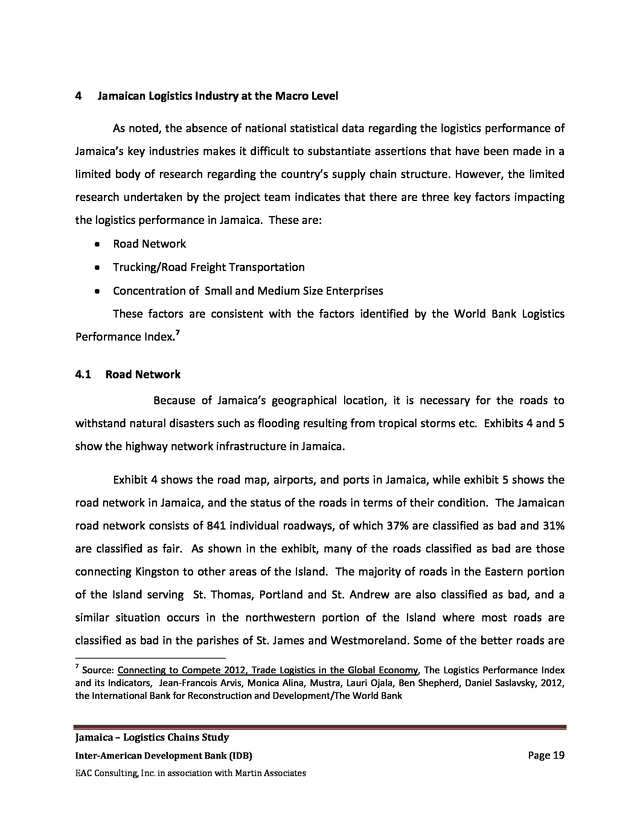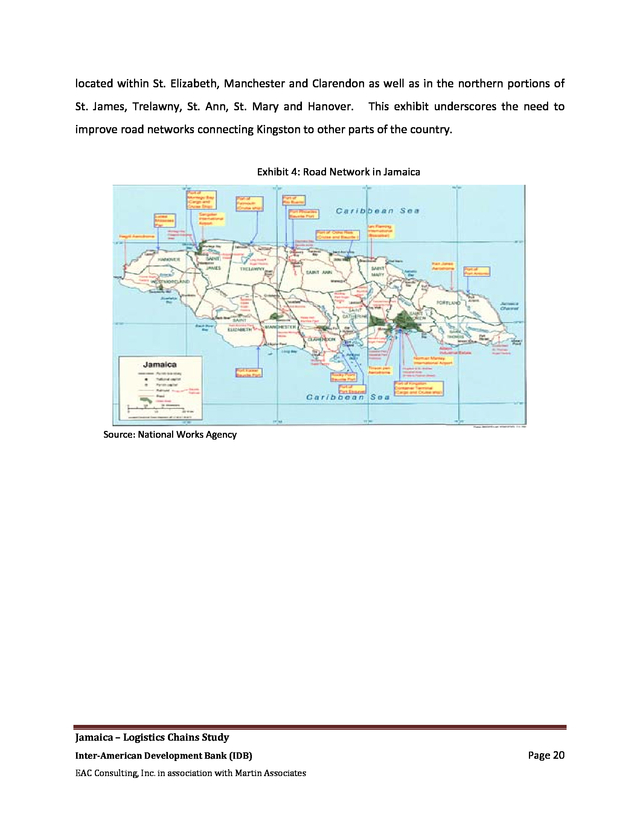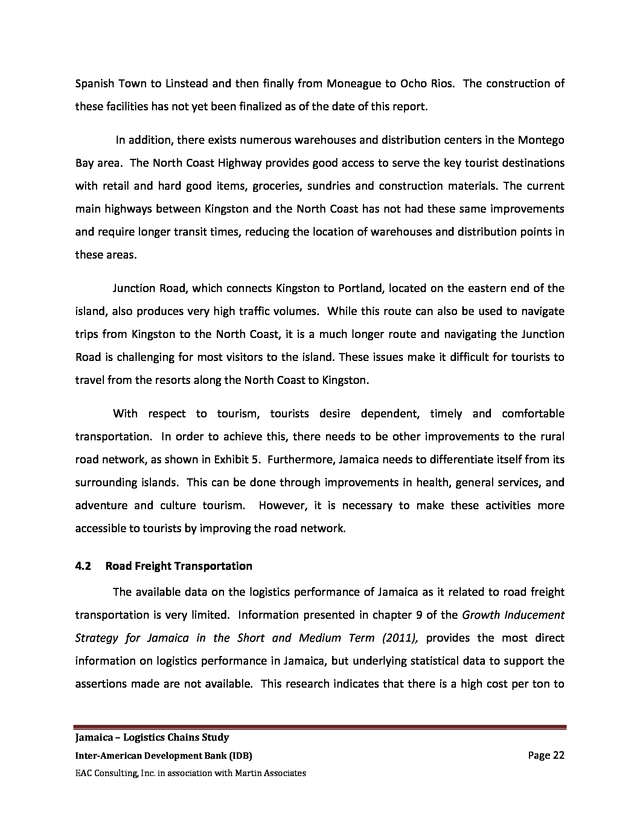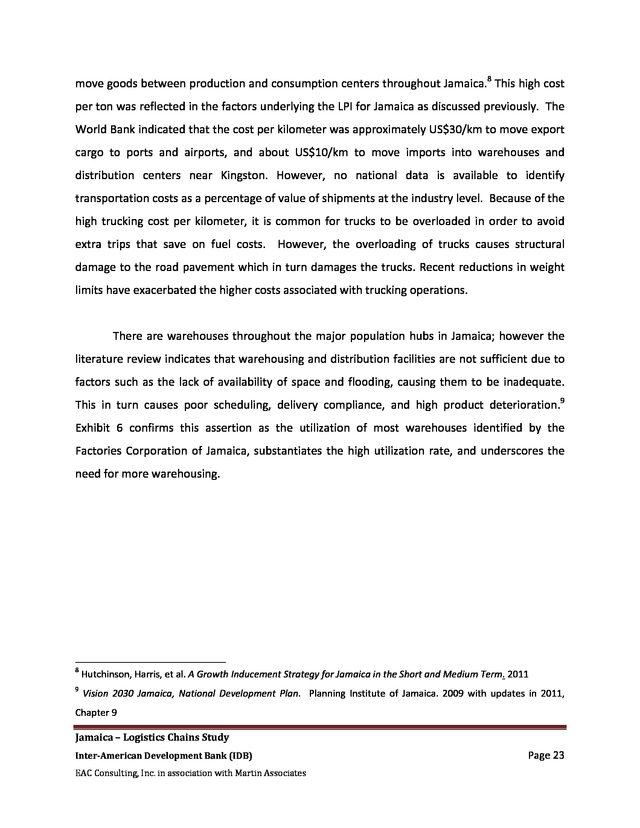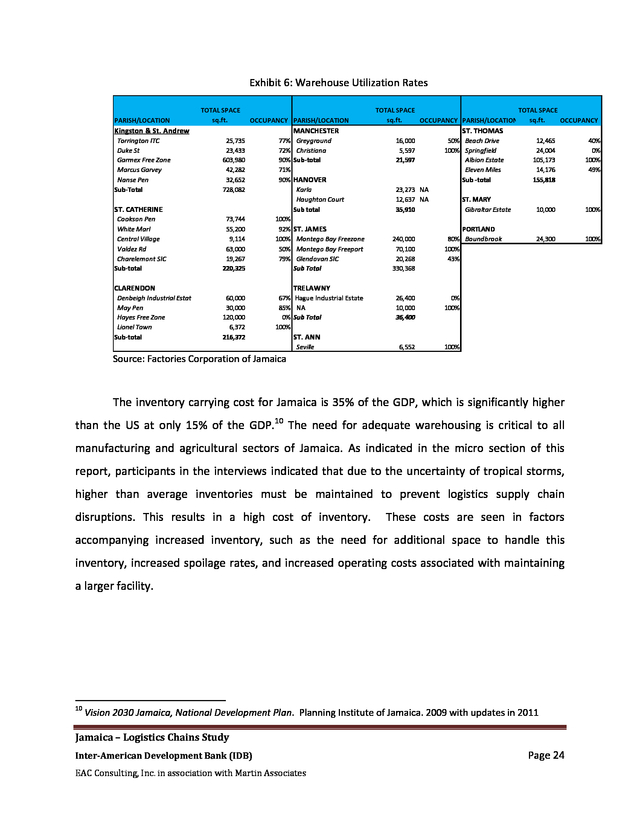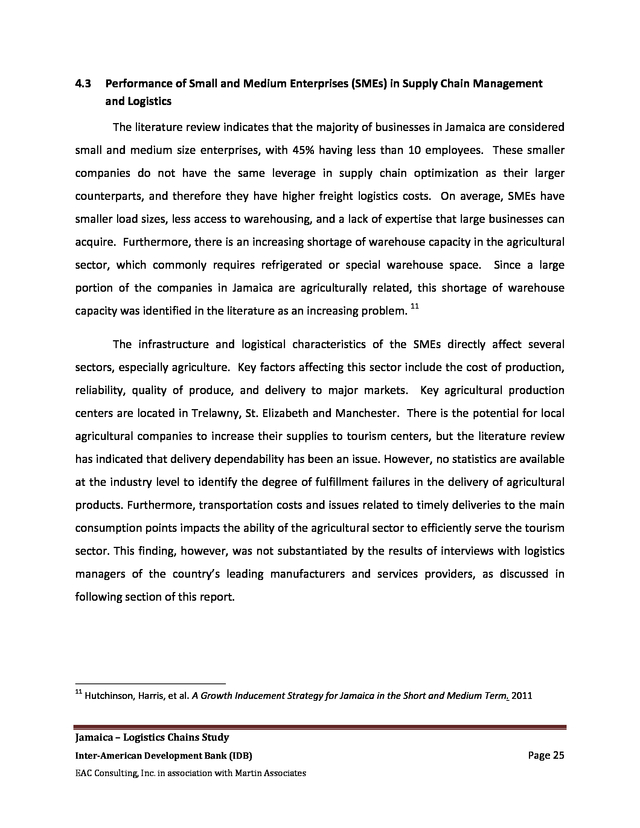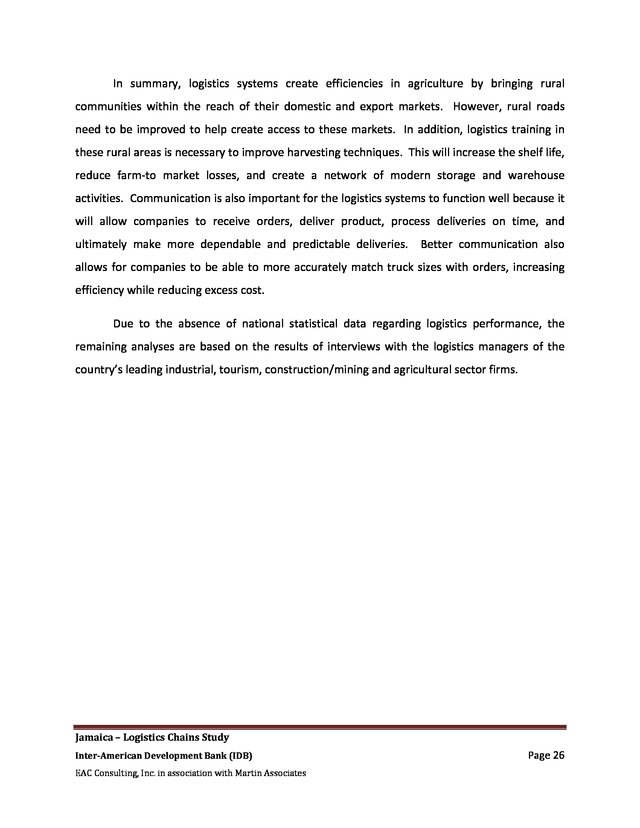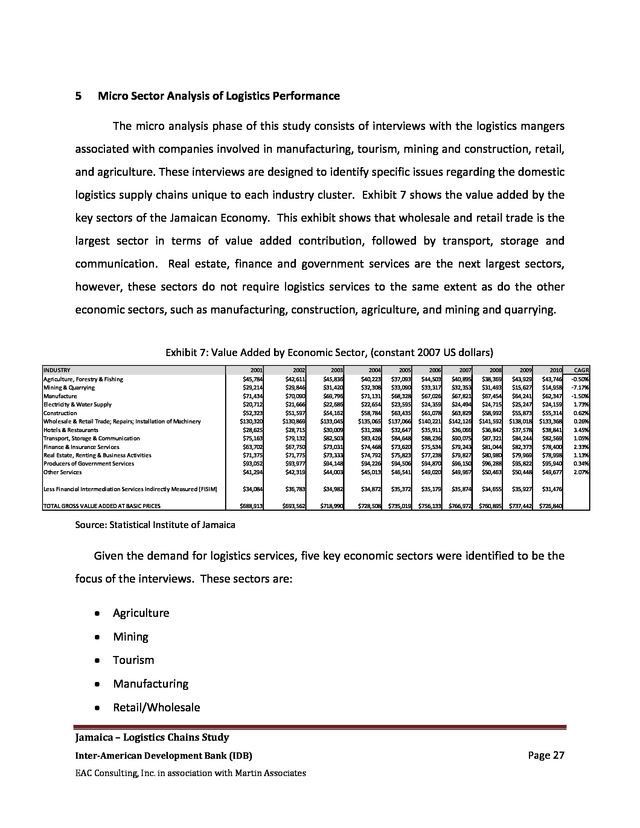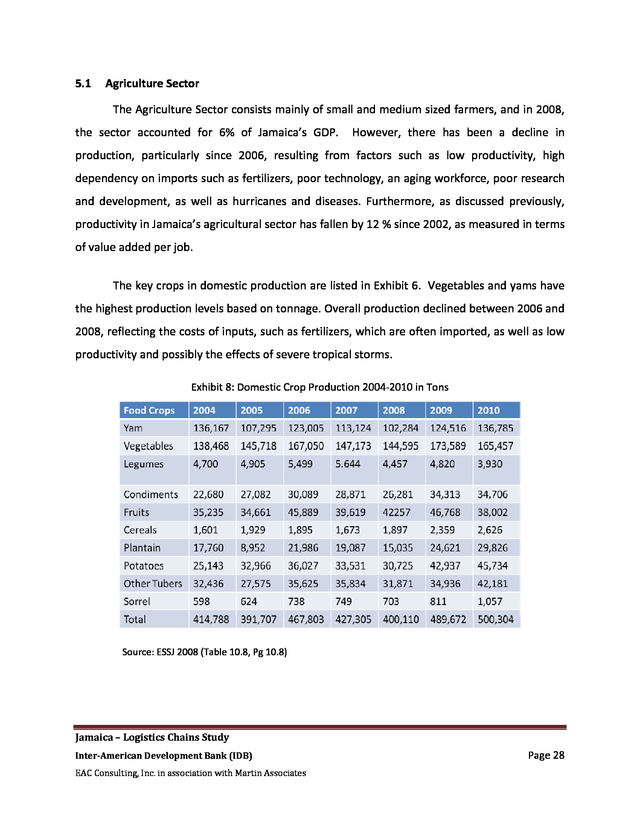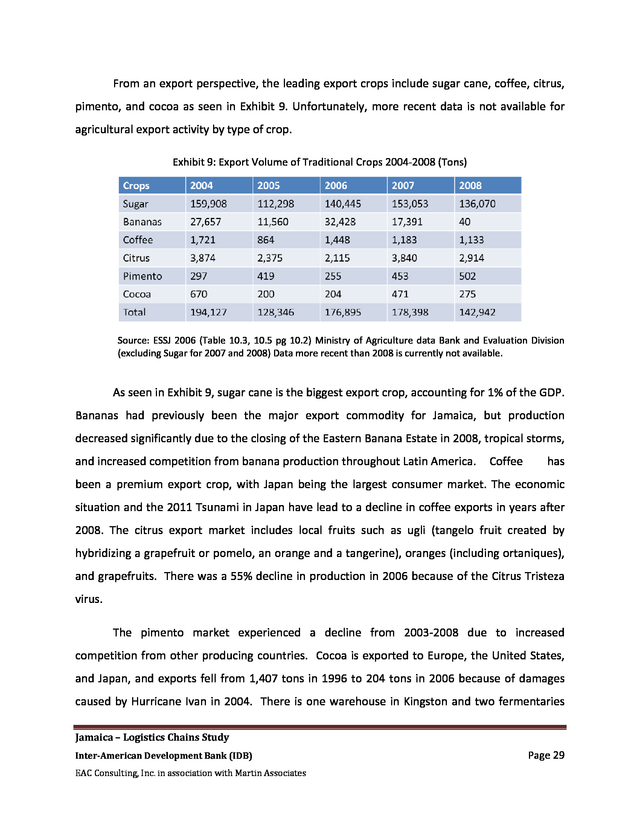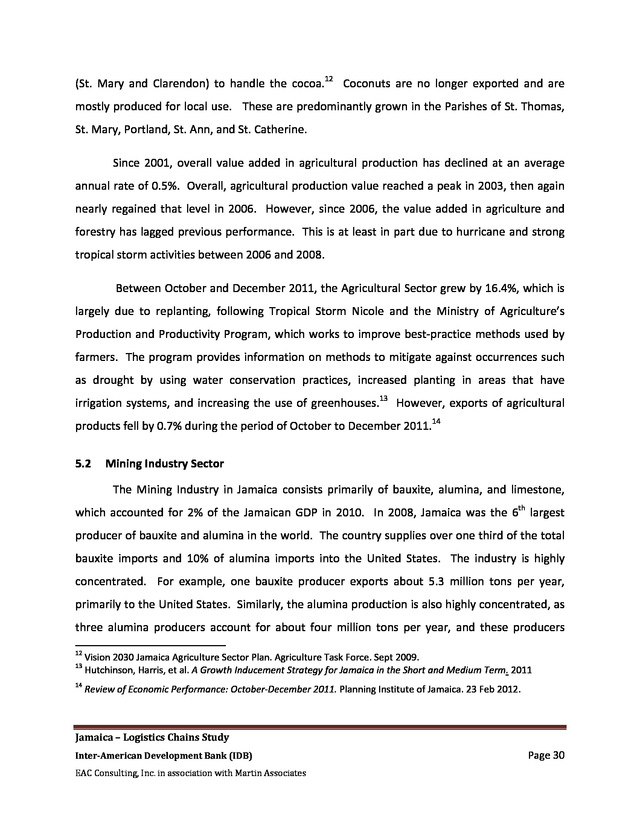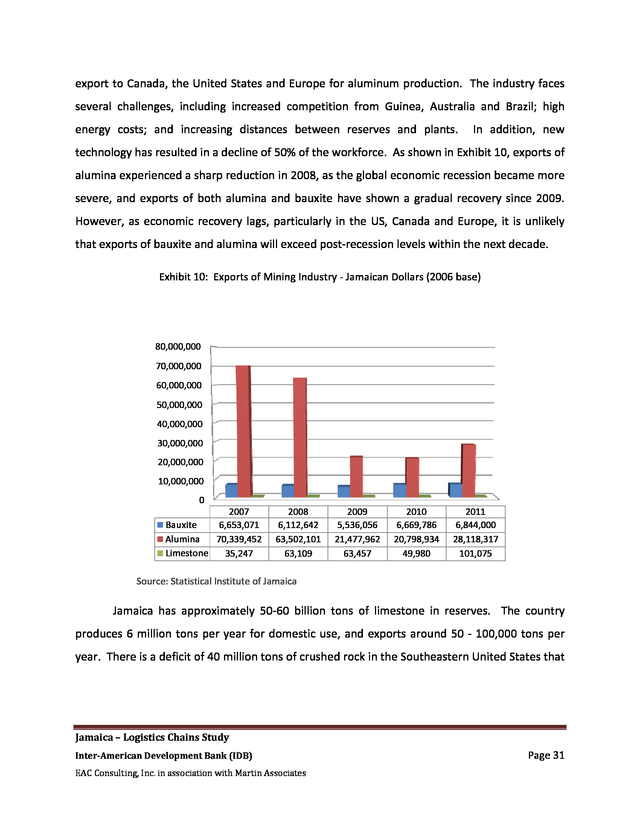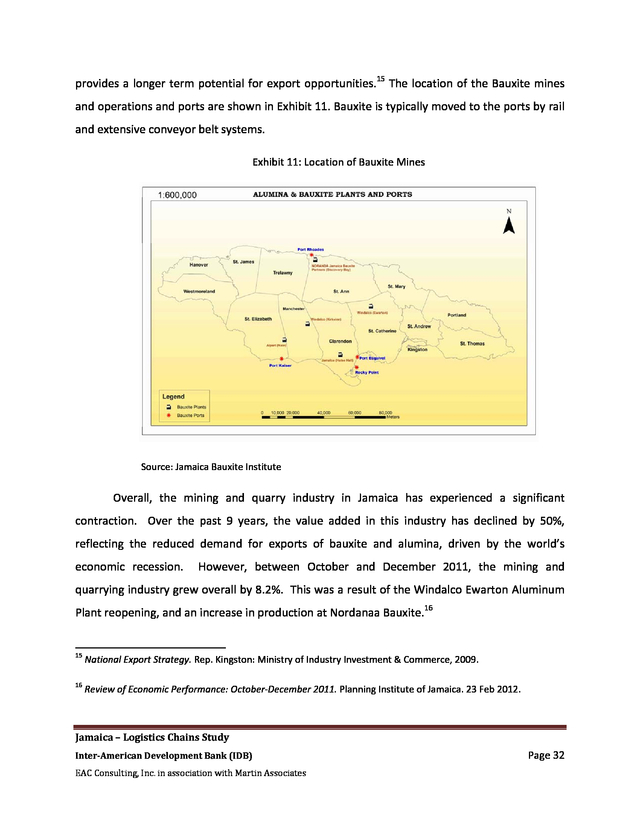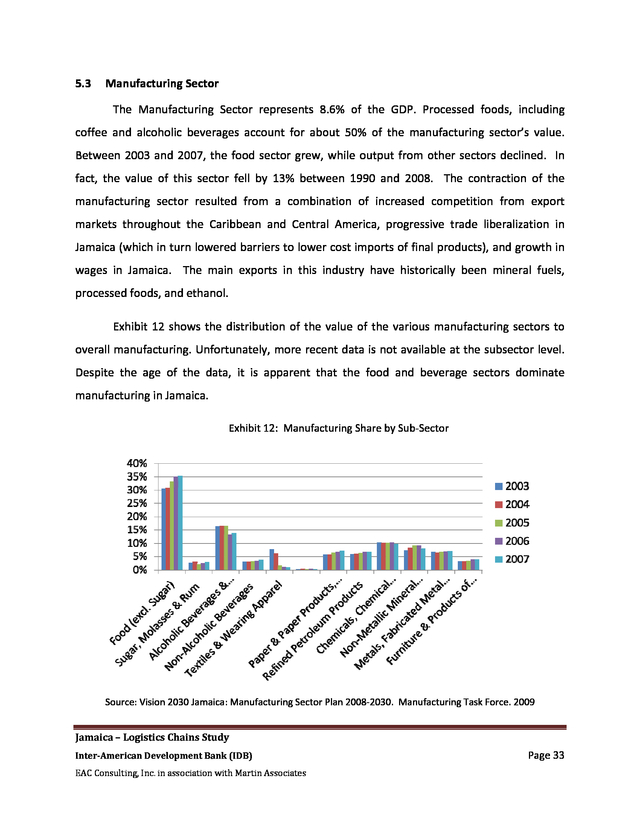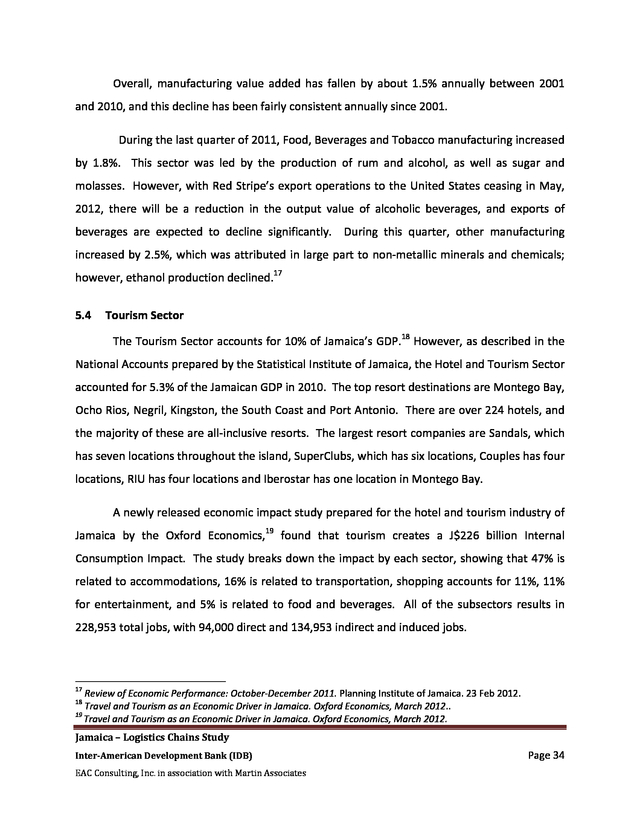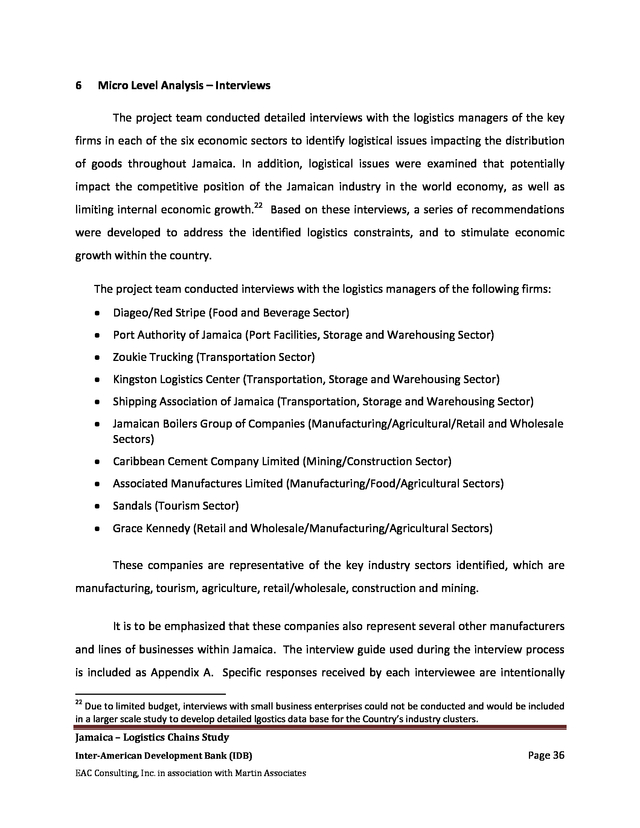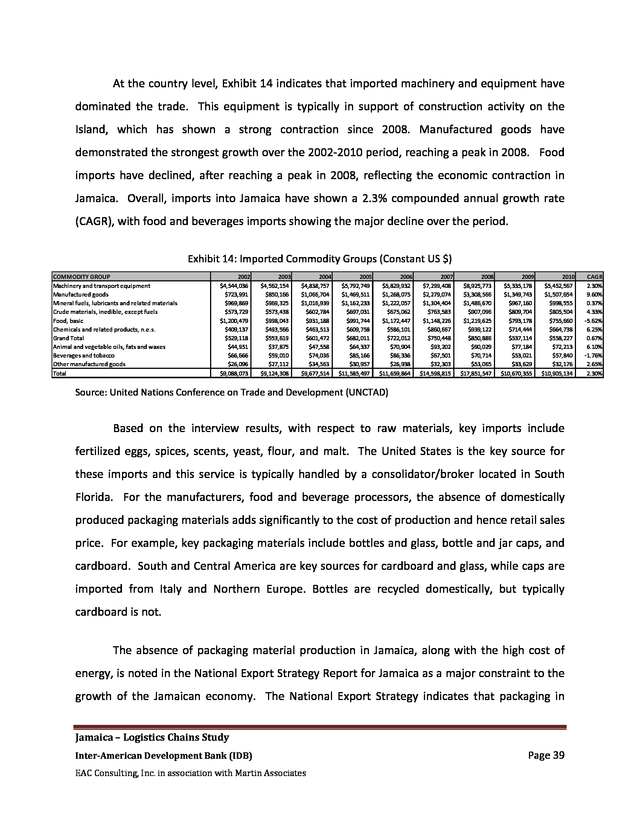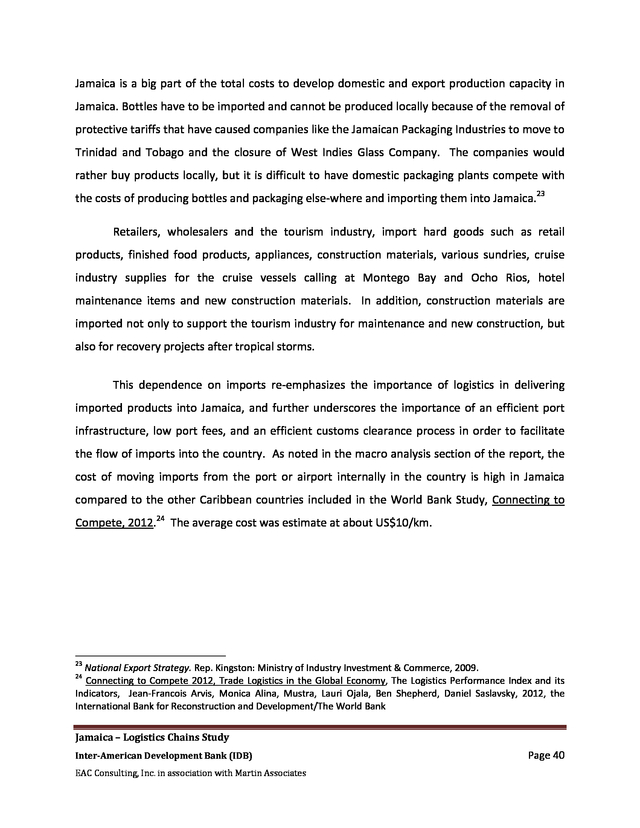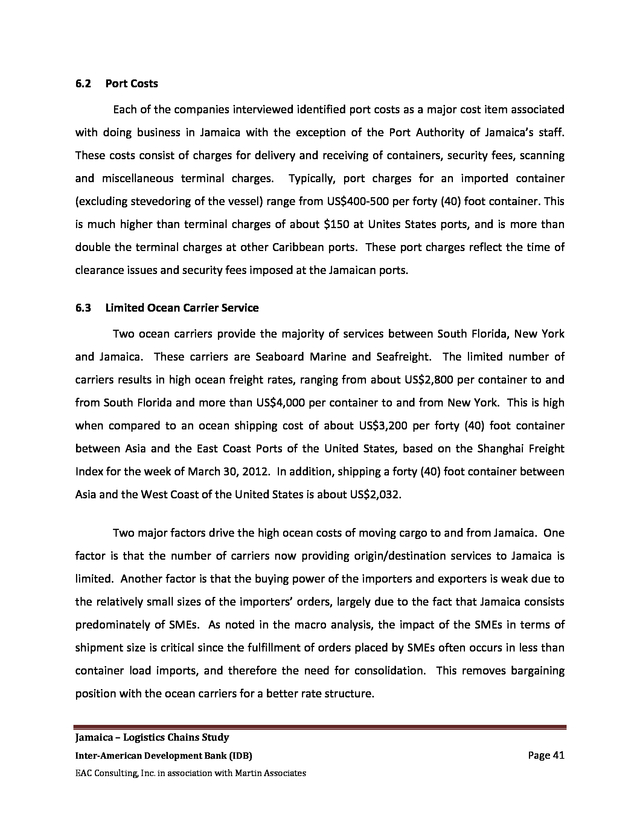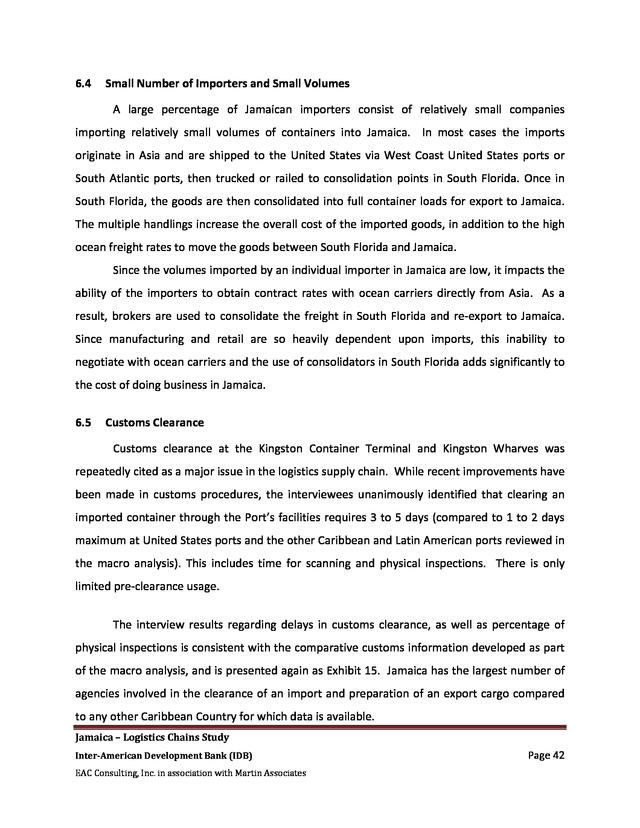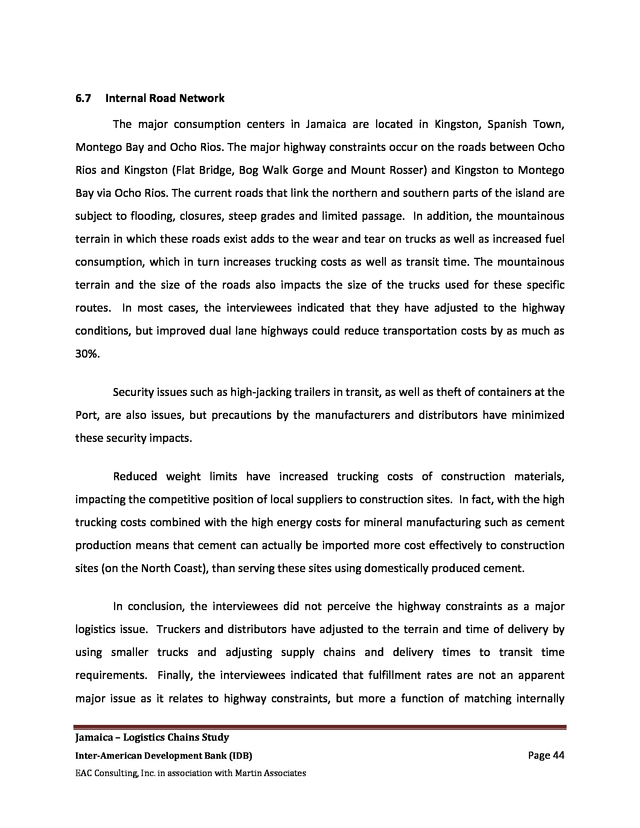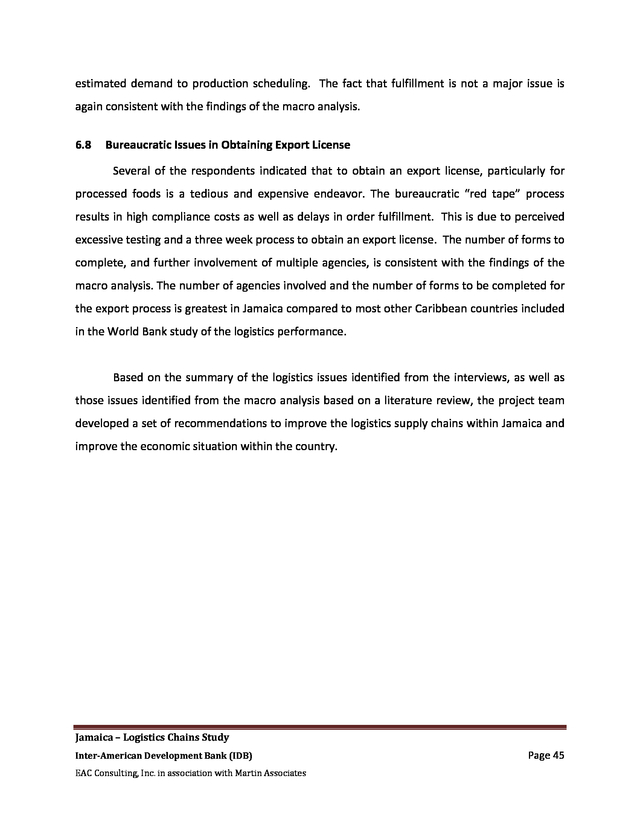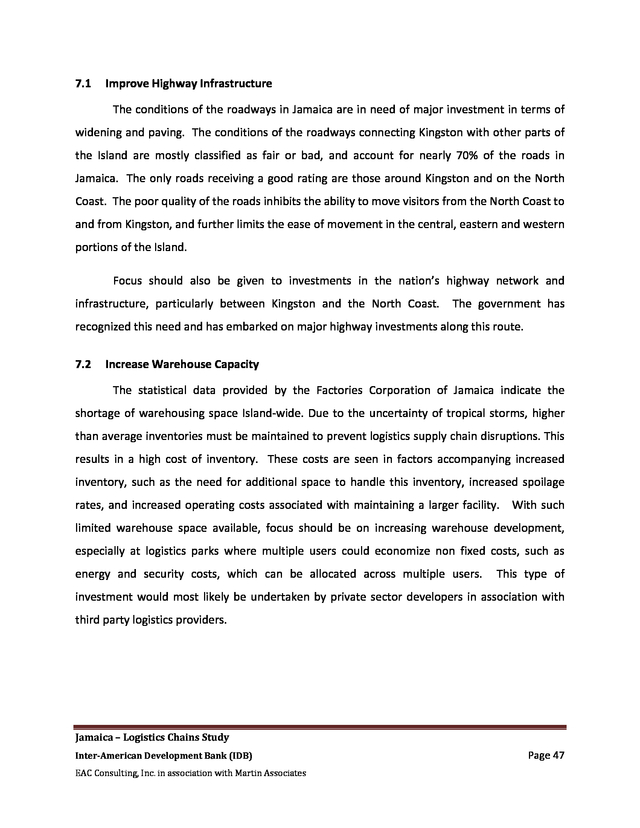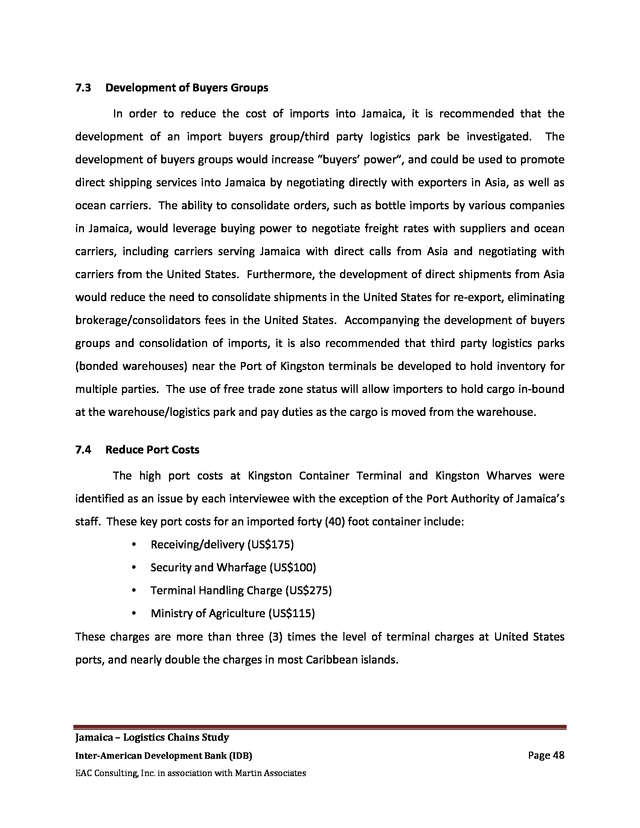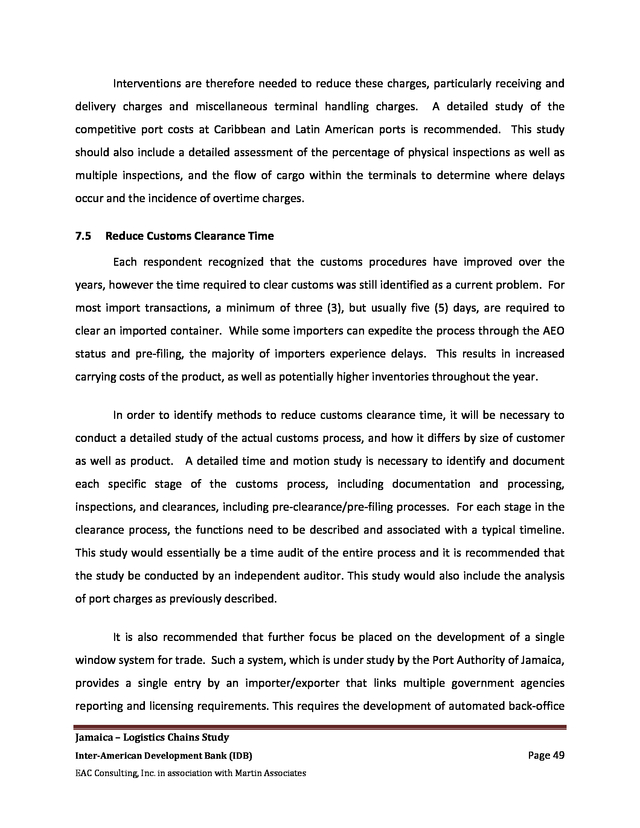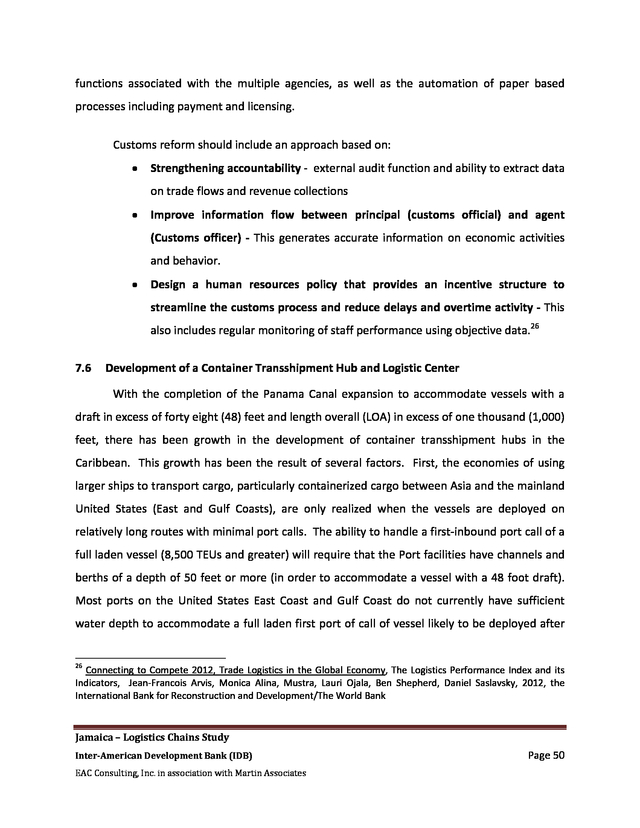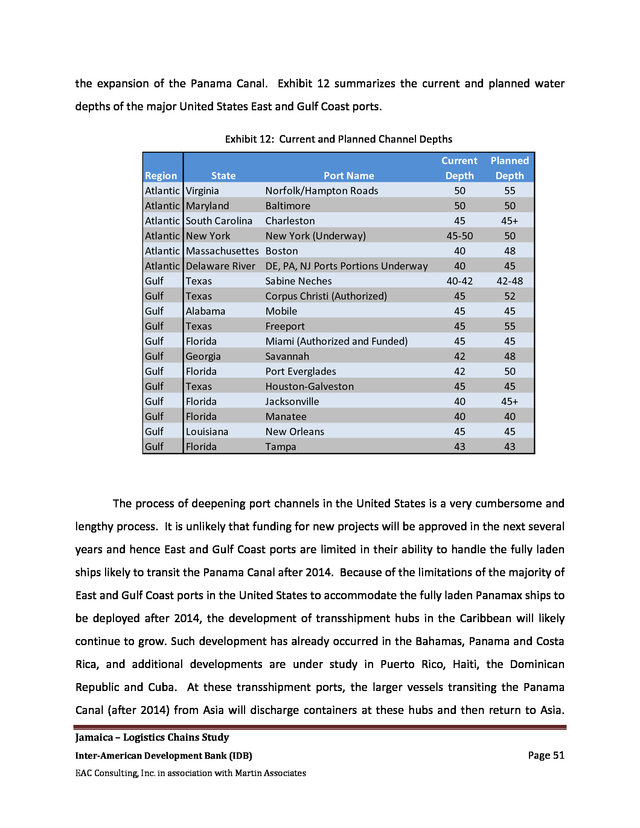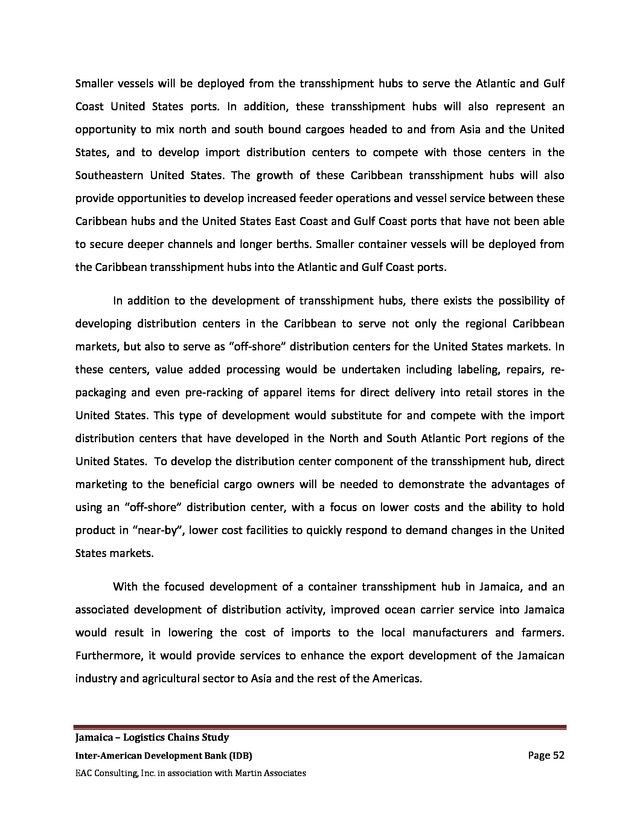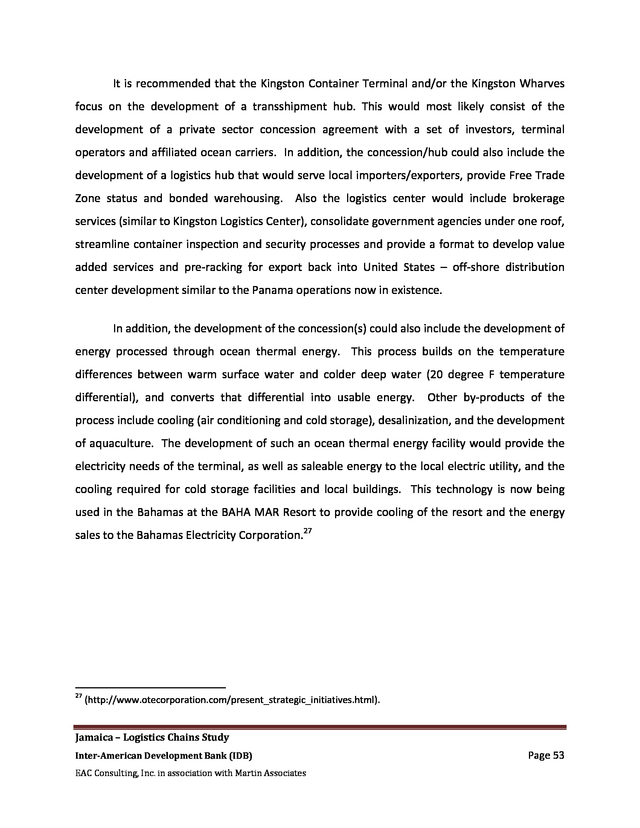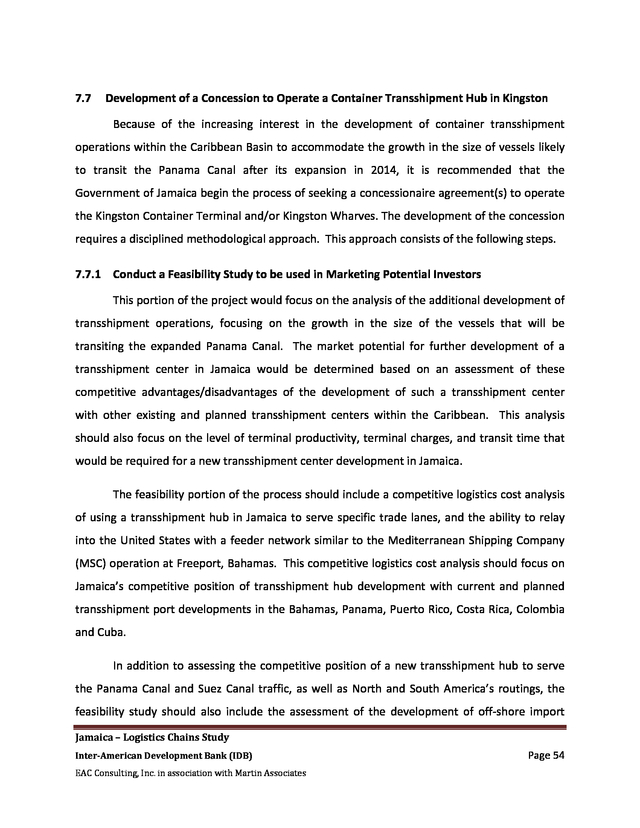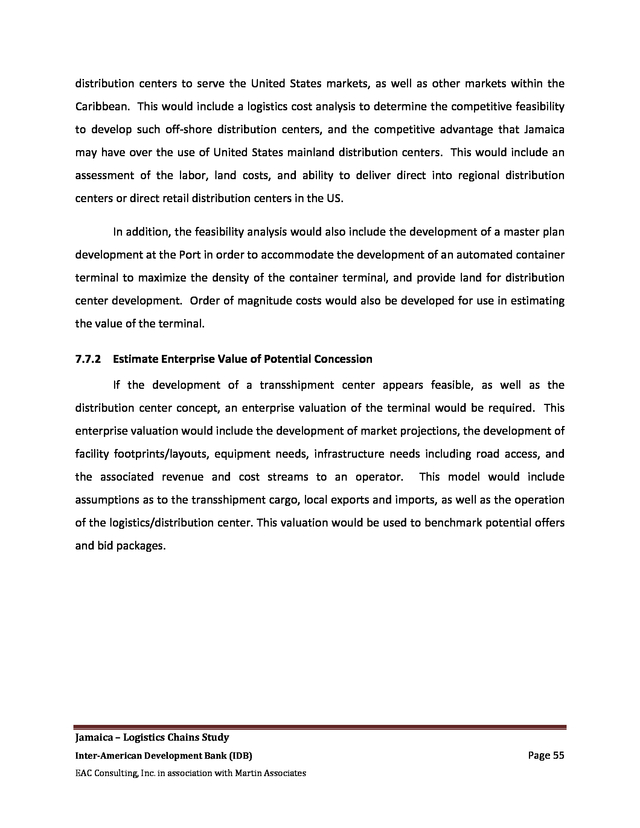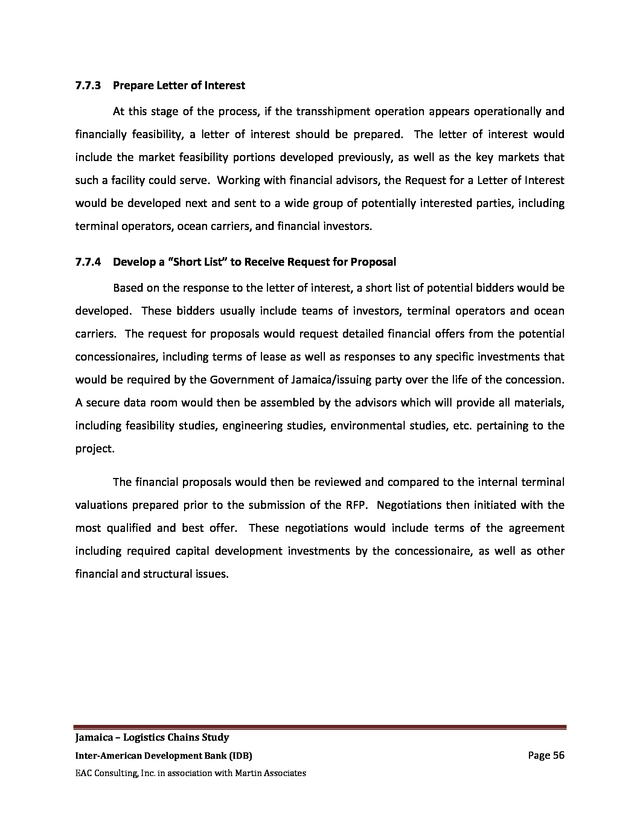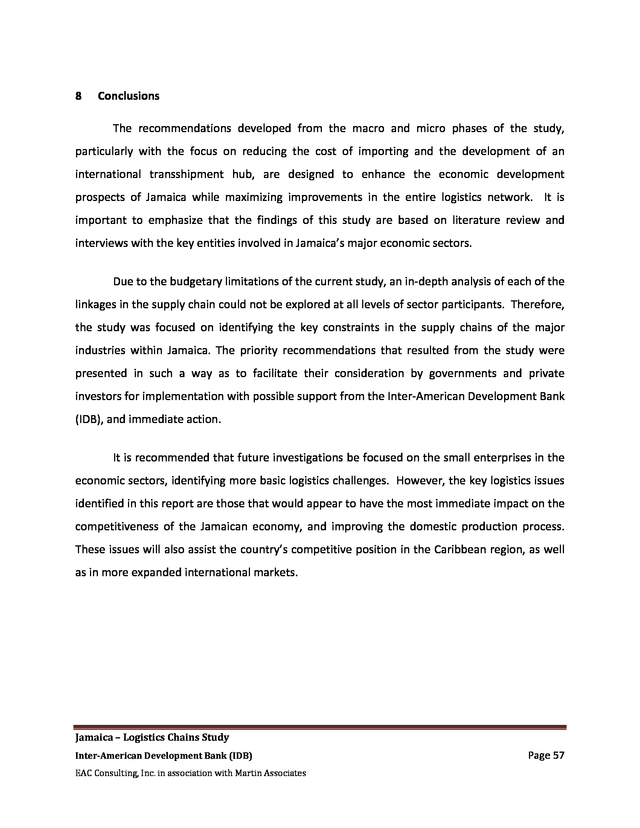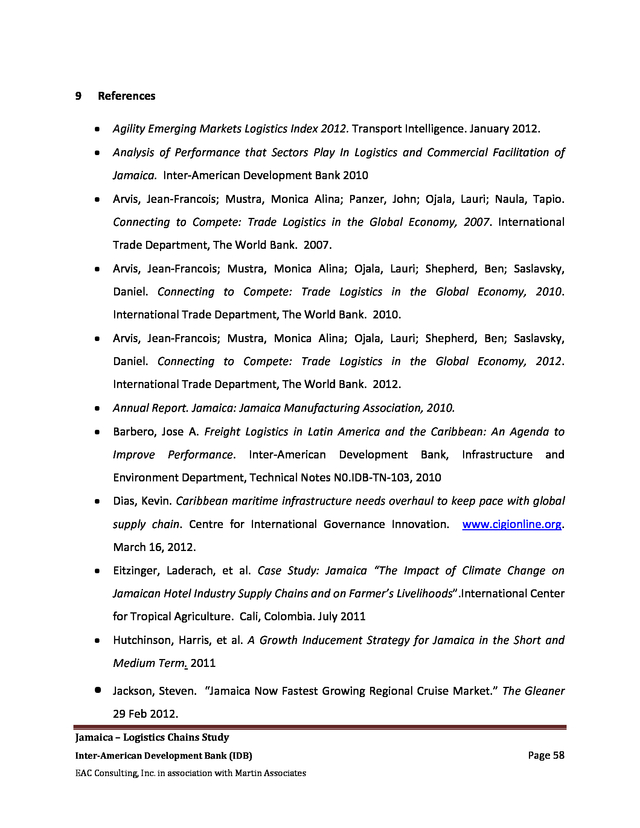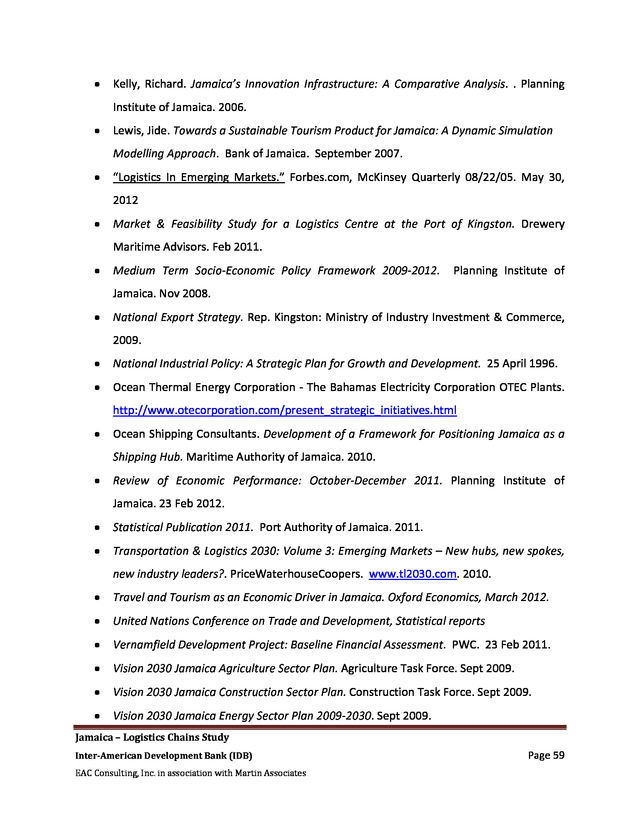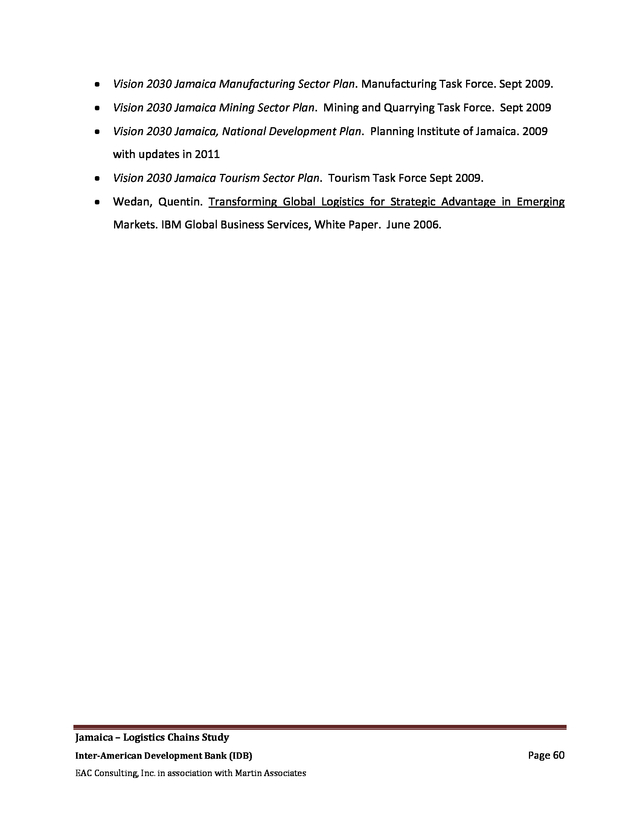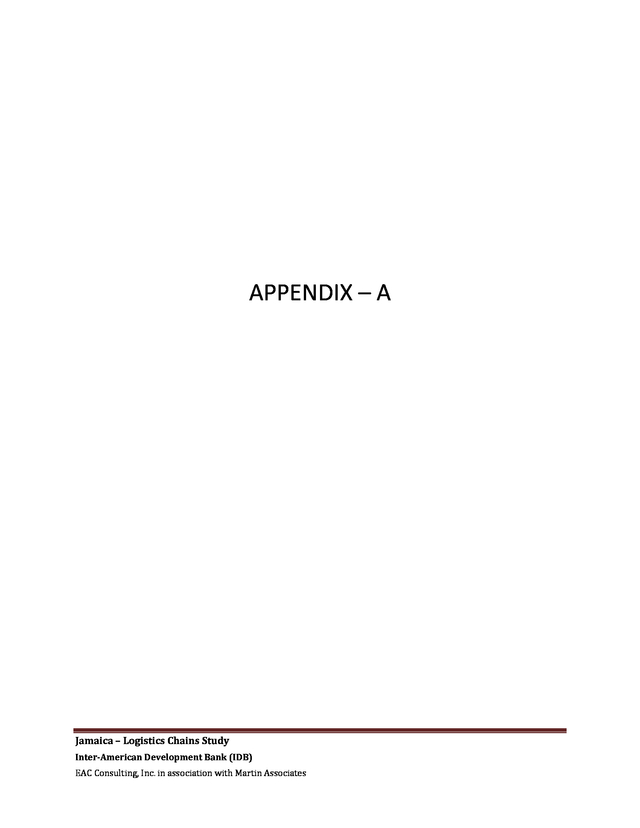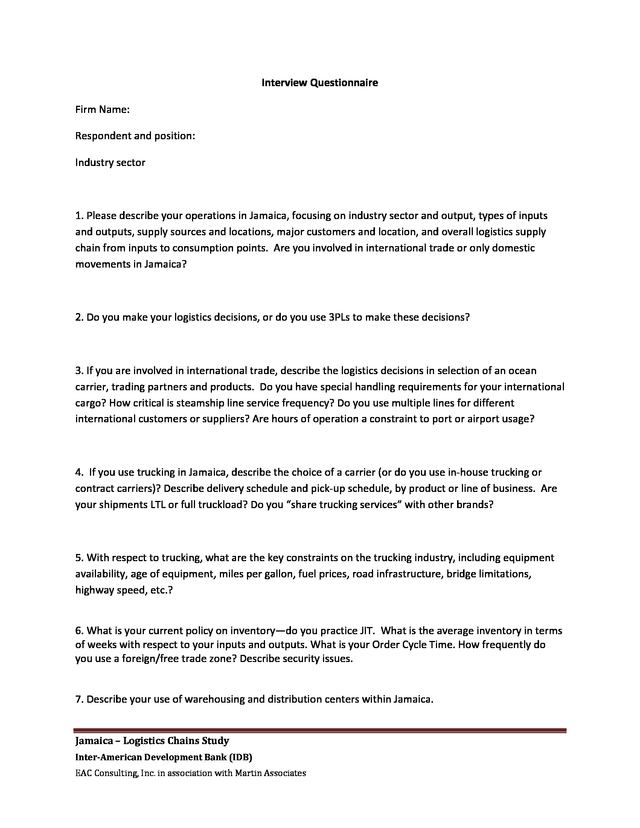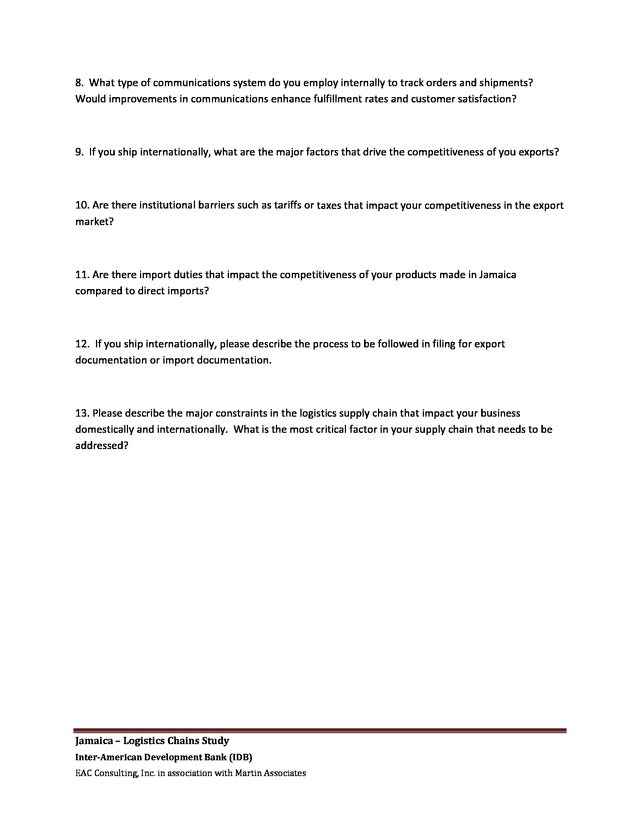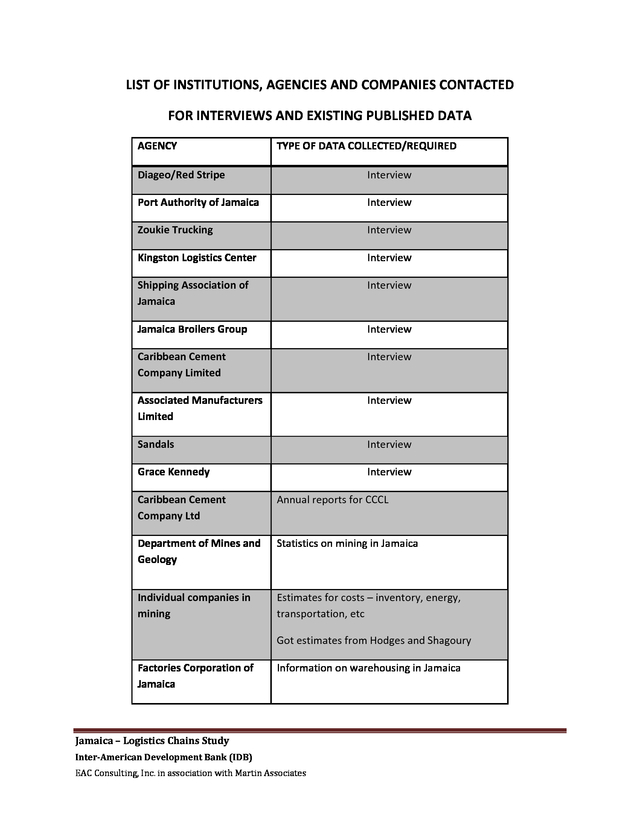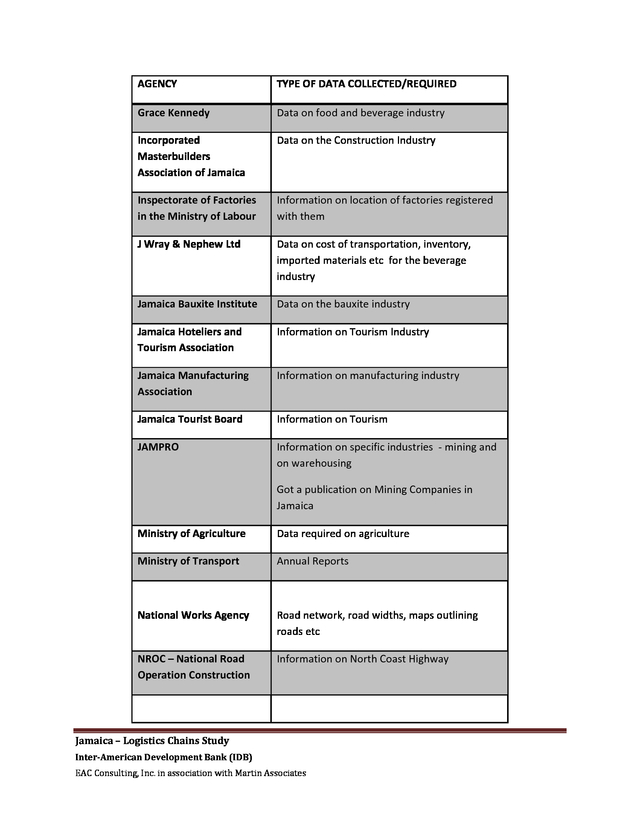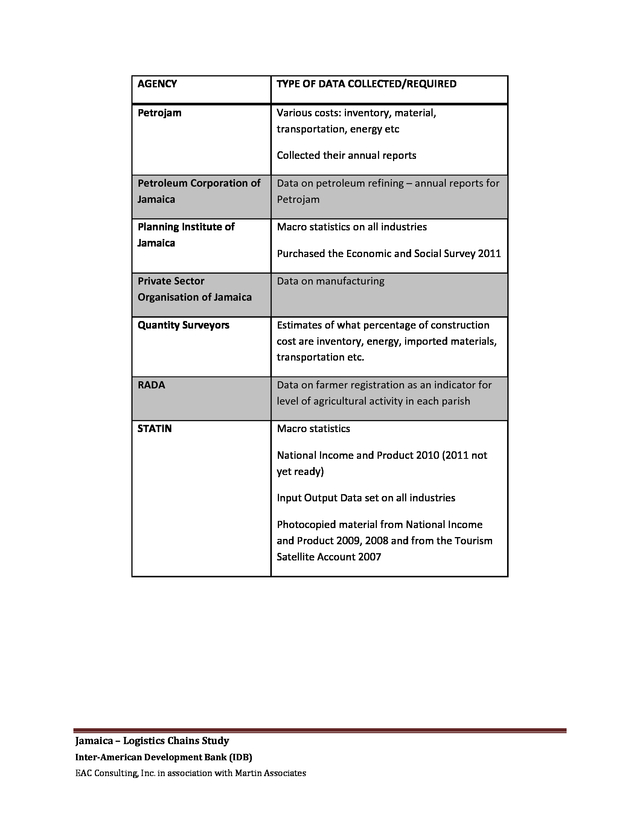




1) Inter-American Development Bank JAMAICA – Logistics Chains Study Final Report March 2013 in association with CA#7011
2) Table of Contents 1 Introduction ........................................................................................................................................................... 1 2 Study Overview ...................................................................................................................................................... 2 2.1 2.2 Performance of the Trucking Industry ......................................................................................................... 5 2.3 Ports ............................................................................................................................................................. 5 2.4 Freight Railways ........................................................................................................................................... 5 2.5 Trade Facilitation ......................................................................................................................................... . 5 2.6 3 Country’s Road Infrastructure ...................................................................................................................... 4 Logistics Management of Small and Medium Sized Enterprises (SMEs) ...................................................... 6 Macro Level Analysis of Logistics Performance ..................................................................................................... 7 3.1 3.2 Global Competiveness Index, World Economic Forum ................................................................................ 9 3.3 Doing Business 2013 †The World Bank Group and the International Finance Corporation ...................... 1 1 3.4 4 Global Enabling Trade Report, World Economic Forum .............................................................................. 7 Logistics Performance Index, World Bank .................................................................................................. 2 1 Jamaican Logistics Industry at the Macro Level .................................................................................................. 9 . 1 4.1 4.2 Road Freight Transportation ...................................................................................................................... 2 2 4.3 5 Road Network ............................................................................................................................................ 9 1 Performance of Small and Medium Enterprises (SMEs) in Supply Chain Management and Logistics ....... 5 2 Micro Sector Analysis of Logistics Performance .................................................................................................. 7 2 5.1 Agriculture Sector ...................................................................................................................................... 8 2 5.2 Mining Industry Sector ............................................................................................................................... 0 3 5.3 Manufacturing Sector ................................................................................................................................ 3 3 5.4 Tourism Sector ........................................................................................................................................... 4 3 5.5 Retail and Wholesale Sector ...................................................................................................................... 5 3 Jamaica – Logistics Chains Study Interâ€American Development Bank (IDB) EAC Consulting, Inc. in association with Martin Associates
3) 6 Micro Level Analysis – Interviews ........................................................................................................................ 6 3 6.1 6.2 Port Costs ................................................................................................................................................... 1 4 6.3 Limited Ocean Carrier Service .................................................................................................................... 1 4 6.4 Small Number of Importers and Small Volumes ........................................................................................ 2 4 6.5 Customs Clearance ..................................................................................................................................... 2 4 6.6 Small Lot Sizes for Internal Delivery ........................................................................................................... 3 4 6.7 Internal Road Network ............................................................................................................................... 4 4 6.8 7 Dependence on Imports ............................................................................................................................ 8 . 3 Bureaucratic Issues in Obtaining Export License ........................................................................................ 5 4 Recommendations ............................................................................................................................................... 6 4 7.1 Improve Highway Infrastructure ................................................................................................................ 7 4 7.2 Increase Warehouse Capacity .................................................................................................................... 7 4 7.3 Development of Buyers Groups ................................................................................................................. 8 4 7.4 Reduce Port Costs ...................................................................................................................................... 8 4 7.5 Reduce Customs Clearance Time ............................................................................................................... 9 4 7.6 Development of a Container Transshipment Hub and Logistic Center ...................................................... 0 5 7.7 Development of a Concession to Operate a Container Transshipment Hub in Kingston .......................... 4 5 7.7.1 Conduct a Feasibility Study to be used in Marketing Potential Investors ............................................. 4 5 7.7.2 Estimate Enterprise Value of Potential Concession ............................................................................... 5 5 7.7.3 Prepare Letter of Interest ...................................................................................................................... 6 5 7.7.4 Develop a “Short List” to Receive Request for Proposal ....................................................................... 6 5 8 Conclusions .......................................................................................................................................................... 7 5 9 References ........................................................................................................................................................... 8 5 LIST OF APPENDICES Appendix A †Interview Questionnaire Appendix B †List of Institutions, Agencies and Companies contacted for Interviews and Existing Data Jamaica – Logistics Chains Study Interâ€American Development Bank (IDB) EAC Consulting, Inc. in association with Martin Associates
4) 1 Introduction The Interâ€American Development Bank (IDB) retained the services of EAC Consulting, Inc., in association with Martin Associates to conduct a Logistics Chains Study for the island of Jamaica. The purpose of the Logistics Chains Study is to identify the major links in Jamaica’s logistics supply chains that includes sources of inputs of labor, capital, and raw materials to production sites; and from the production sites to storage facilities, major logistics hubs, local markets and international gateways. The study targets the major types of freight logistics services including cargo transportation by land and sea, warehousing, consolidation, customs clearing and forwarding, container operations, and multiâ€modal transportation. Other areas of interest include cargo handling at ports as well as valueâ€added services, such as the provision of warehousing and supply chain management solutions. Due to the budgetary limitations of the current study, an inâ€depth analysis of each of these linkages in the supply chain could not be explored. Therefore, the study is focused on identifying the key constraints in the supply chains of the major industries within Jamaica, and the impact of freight logistics on the competitiveness of Jamaica’s industry and economic sectors, both domestically and internationally. A set of recommendations has been developed to improve the domestic logistics system within Jamaica, as well as to improve the international competitive position of Jamaica in terms of international transshipment and logistics. The results from the study have been arranged in such a way as to facilitate their consideration by governments and private investors for implementation with possible support from the IDB. Jamaica – Logistics Chains Study Interâ€American Development Bank (IDB) EAC Consulting, Inc. in association with Martin Associates Page 1
5) 2 Study Overview An assessment of the internal logistics systems within a country involves the analysis of the inbound logistics of raw materials moving to the production process sites and the outbound logistics of moving products from the production process sites to markets. This includes domestic products as well as imported and exported products. The critical elements of a logistics supply chain include the following elements: ï‚· Infrastructure: – Highways – Airports – Ports – Rail – Warehousing/Distribution Centers ï‚· Regulatory: – Customs – Immigration – Tariffs – Security ï‚· Information flow: – Tracking of goods and inputs – Integrated systems of transportation service providers with shippers/consignees – Inventory control policies The study consists of two (2) phases. The first phase of the study is a macro overview of the current logistics industry in Jamaica and how Jamaica compares with other Caribbean countries with respect to the efficiency of the logistics supply system, both internally and externally. The second phase of the study is a micro analysis that is based on interviews with logistics managers of leading industries in Jamaica. Jamaica – Logistics Chains Study Interâ€American Development Bank (IDB) EAC Consulting, Inc. in association with Martin Associates Page 2
6) The macro analysis is based on a review of the literature focusing on logistics systems in emerging markets, and identifies Jamaica’s relative position with respect to the logistics supply systems present in other similar markets. In addition, the literature review provides a summary of the key factors within the logistics systems of emerging countries and identifies potential solutions to specific areas of concern within the logistics supply chain. These macro findings are then cross referenced with the results of the interviews with the logistics managers of Jamaica’s leading industries (micro analysis) that represent the Country’s major economic sectors. In assessing the comparative logistics systems at the country level, the major obstacle is the absence of consistent and quantifiable data. As described in the Interâ€American Development Bank’s publication, Freight Logistics in Latin America and the Caribbean: An Agenda to Improve Performance1, “the performance of logistics in a given territory (a country for example), is not easy to measure or interpret.” The IDB report identifies three methods used to assess the logistics performance of a country. These are as follows: – A Macro approach based on national accounts that focuses on the relationship of transportation costs as a percentage of Gross Domestic Product; – A Micro approach which is based on interviews with key companies operating within a country; and – A Perception approach, which is based on performance indicators, developed from a large survey of transportation industry stakeholders. However, because of the complexity of the logistics systems and the uniqueness of these systems between countries and industries, it is difficult to develop such indicators for use in detailed analyses. The lack of transportation cost data and inventory data at the macro country level in most emerging markets, such as Jamaica and the Caribbean region in general, further complicates the development of logistics indicators, and exacerbates the task of identifying 1 Freight Logistics in Latin America and the Caribbean: An Agenda to Improve Performance, Jose A. Barbero, Inter†American Development Bank, Infrastructure and Environment Department, Technical Notes N0.IDBâ€TNâ€103, 2010 Jamaica – Logistics Chains Study Interâ€American Development Bank (IDB) EAC Consulting, Inc. in association with Martin Associates Page 3
7) intraâ€country logistics performance metrics as well as comparisons between countries. The most reliable and comprehensive logistics indicator is the Logistics Performance Index (LPI), which is documented in a publication by the World Bank in 2007, 2010 and 20122. This index is based on a survey of more than 1,000 transportation service providers in over 150 countries, and will be used in this macro assessment to provide interâ€country comparisons between the logistics supply chain in Jamaica and other Caribbean and Latin American countries. A review of the factors underlying the performance of a country’s logistics infrastructure indicates six major areas that are most critical in affecting the logistics supply chain.3 These factors are as follows: – Country’s Road Infrastructure – Performance of the Trucking Industry – Ports – Freight Railways – Trade Facilitation – Logistics Management of Small and Medium Sized Enterprises (SMEs) 2.1 Country’s Road Infrastructure Overall, the existing conditions of the roadway system in most Caribbean and Latin American countries reflect structural issues, including road degradation, a high ratio of unpaved to paved roadways, and mountainous terrain. An investment in road networks has been found to have a direct influence on freight logistics costs and enhances the mobility of a country’s population. 2 Connecting to Compete 2012, Trade Logistics in the Global Economy, The Logistics Performance Index and its Indicators, Jeanâ€Francois Arvis, Monica Alina, Mustra, Lauri Ojala, Ben Shepherd, Daniel Saslavsky, 2012, the International Bank for Reconstruction and Development/The World Bank. 3 Freight Logistics in Latin America and the Caribbean: An Agenda to Improve Performance, Jose A. Barbero, Inter†American Development Bank, Infrastructure and Environment Department, Technical Notes N0.IDBâ€TNâ€103, 2010 Jamaica – Logistics Chains Study Interâ€American Development Bank (IDB) EAC Consulting, Inc. in association with Martin Associates Page 4
8) 2.2 Performance of the Trucking Industry Within the Caribbean and Latin American economies, the trucking system dominates internal trade flows. However, limited macro data is available on the status of the region’s trucking industry. The ability to utilize fullâ€truck load shipments is important in minimizing trucking costs, but due to the dominance of small scale manufacturers and farming, less than a truck load (LTL) shipments are prominent in the Caribbean and Latin American markets. Consolidation of shipments to reduce the number of LTL shipments should be a goal for improving intraâ€country logistics and reducing trucking costs. 2.3 Ports The port system is the most critical node in the Caribbean region, due to the importance of international trade. It is noted that the development of public private partnerships in the port sector of the Caribbean and Latin American countries has resulted in acceptable port infrastructure, however overall port management models and associated regulatory structures are areas in need of improvement. The impact of investment in port infrastructure and management is critical to a country’s competitive position. 2.4 Freight Railways Railway usage is typically limited in Caribbean countries, and is frequently dedicated to bulk logistics movements as it plays an important role in connecting the ports to bulk operations. Private investment is characteristic of railway infrastructure investments. In addition to moving freight, railway usage also reduces emissions compared to trucking operations, and further reduces road damage and maintenance costs, as bulk materials are moved more efficiently by rail. 2.5 Trade Facilitation The factors that drive trade facilitation include regulatory policies, administrative structure, and documentation procedures. It is this area that research has indicated the lowest levels of development in the Caribbean and Latin American region. Next to port efficiencies, Jamaica – Logistics Chains Study Interâ€American Development Bank (IDB) EAC Consulting, Inc. in association with Martin Associates Page 5
9) previous studies by the IDB indicate that the factors that most influence a country’s competitiveness are customs efficiency and eâ€commerce. A focus on improving customs procedures and the time to clear customs are of paramount importance within the region. 2.6 Logistics Management of Small and Medium Sized Enterprises (SMEs) The Caribbean and Latin American region is characterized by a high concentration of employment within SMEs, but the importance of SMEs on international trade and competitiveness is limited. Analysis and research on the logistics structure of SMEs is very limited, however the data indicates that their logistics costs are two to three times larger than those of larger companies. Lack of monitoring of logistics costs within SMEs presents a measurement limitation, both in terms of transportation costs and inventory costs. Finally, the IDB report on Freight Logistics in Latin America and the Caribbean, states that “the Caribbean Islands are a special case”. Because of their small size, internal logistics is hardly relevant, and the administration of ports and airports as well as maritime and aero†commercial accessibility is of more importance. Studies on logistics performance seem to exclude smaller countries, thus making existing literature ineffective to identify needs4. 4 Freight Logistics in Latin America and the Caribbean: An Agenda to Improve Performance, Jose A. Barbero, Inter†American Development Bank, Infrastructure and Environment Department, Technical Notes N0.IDBâ€TNâ€103, 2010 Jamaica – Logistics Chains Study Interâ€American Development Bank (IDB) EAC Consulting, Inc. in association with Martin Associates Page 6
10) 3 Macro Level Analysis of Logistics Performance As noted in the overview, macro countryâ€wide transportation industry statistics are essentially nonâ€existent for most Caribbean Island countries, including Jamaica. As part of the literature review, the project team conducted numerous interviews with members of the Statistical Institute of Jamaica (STATIN), as well as reviewed data maintained by CARICOM and the Planning Institute of Jamaica (PIOJ), in an attempt to identify macro logistics industry indicators such as transportation costs as a percent of value of goods sold, import share of value of goods sold, inventory carrying costs, and average inventory turn times. The lack of such published industry data complicates the ability of the project team to provide macro comparative analyses, and results in the need to review current and historical logistics performance indices prepared by the World Bank. These logistics performance indices are the recognized metric used by economic and research institutions to understand the logistics deficiencies within these countries, and compare on a standard basis the logistics performance between countries of similar size and geographic location. A review of these indices was undertaken and relevant aspects are summarized below. It is to be emphasized that all of these indices are macro in general, and can only be used for general information and for contextual purposes. 3.1 Global Enabling Trade Report, World Economic Forum The Enabling Trade Index ranks countries based on their level of necessary elements in place for enabling trade and whether there are improvements needed. The Index is divided into subâ€indices which include: Market Access, Border Administration, Transport & Communication Infrastructure, and Business Environment. Each category is broken down into pillars, which are also ranked. These combine to form an overall subâ€index ranking for each country. Jamaica ranked 79th out of 132 countries in the Enabling Trade Index. Other Caribbean countries ranked in the index comparison include Costa Rica at 43rd, Honduras at 78th, Nicaragua at 82nd, the Dominican Republic at 87th, Colombia at 89th, and Haiti at 128th. Jamaica – Logistics Chains Study Interâ€American Development Bank (IDB) EAC Consulting, Inc. in association with Martin Associates Page 7
11) The first subâ€index is associated with Market Access, which analyzes how welcoming countries are with regards to imports and examines the level of foreign market access available for the countries’ exporters. The quality of the trade system and the level of protection that both importers and exporters have are also included in the analysis. Jamaica ranked 58th in this category, better than its overall ranking of 79th. The second subâ€index is associated with Border Administration. This index looks at how efficiently imports and exports occur within a country. This is further broken down into the following categories: Efficiency of Customs Administration, Efficiency of Importâ€Export procedures, and Transparency of Border Administration. Efficiency of Customs Administration looks at the services that are provided by customs authorities and other related agencies. Jamaica ranked 54th in this category. The Efficiency of Importâ€Export Procedures section evaluates the effectiveness and efficiency of clearance processes by customs and border control. This includes factors such as the number of days and documents required to import/export goods as well as the total cost associated with these activities, excluding tariffs. Jamaica ranked 84th, which is a relatively low ranking. Transparency of Border Administration looks at the prevalence of using undocumented extra payments or bribes that are connected with imports and exports as well as the perceived corruption of the country. Jamaica ranked 79th in this category. The third subâ€index is associated with Transport and Communications Infrastructure and determines whether a country has the necessary transportation and communication infrastructure in place to help facilitate the efficient movement of goods within the country as well as outside of its borders. Availability and quality of transportation infrastructure, availability and quality of transportation services, and availability and use of ICTs (Information and Communication Technology) are examined to create a weighted rank of 61st for Jamaica. Availability and quality of transportation infrastructure looks at factors such as percent of paved roads, the density of airports, and the level of transshipment connections available from the countries. It also takes into account the quality of the various types of transportation Jamaica – Logistics Chains Study Interâ€American Development Bank (IDB) EAC Consulting, Inc. in association with Martin Associates Page 8
12) infrastructure that are in place. With these subâ€categories, Jamaica ranked 45th, a relatively high ranking. For availability and quality of transport services, Jamaica ranked 74th. The number and quality of services available for shipments, such as liner services, the ability to track and trace international shipments, the timeliness of shipments in reaching their destination, general postal efficiencies, and overall competence of the local logistics industry are all taken into consideration in this ranking process. Jamaica ranked 78th in the availability and use of ICTs. ICTs are becoming increasingly more important for managing shipments and play a big role in facilitating customs clearance and communication. The fourth subâ€index is associated with the Business Environment, and examines the quality of governance and the regulatory and security environment by looking at the regulatory environment and the physical security subsectors. Overall Jamaica is ranked at 105th, a very poor ranking. The regulatory environment evaluates how conducive the country’s regulatory government is to trade by assessing the quality and openness to foreign labor in the country as well as policies and trade agreements. Jamaica ranked 69th for this subsector. However, Jamaica ranked 118th for physical security, which assesses each country’s level of crime and violence and how well the police force can enforce laws since this is can affect the delivery of goods. This index suggests the weakest performance by Jamaica is in the governance of the regulatory process, including a very poor performance in physical security. In addition, Jamaica has a very poor rating with respect to days and number of documents required in the export and import documentation process. 3.2 Global Competiveness Index, World Economic Forum The ability for a country to be competitive is important for its sustainability and prosperity. The Global Competiveness Index was developed by the World Economic Forum as a way to assess the competitiveness of countries throughout the world and provide guidance for improvements. The index looks at several categories, which are combined to determine each Jamaica – Logistics Chains Study Interâ€American Development Bank (IDB) EAC Consulting, Inc. in association with Martin Associates Page 9
13) country’s competitive state. These components fall under three categories: Basic Requirements for competiveness, Efficiency Enhancers, and Innovation and Sophistication Factors. With all components combined, Jamaica ranked 97th out of the 144 countries included in the Index, placing Jamaica in the bottom oneâ€third. Other Caribbean countries included in the Index are Puerto Rico which ranked 31st, Panama ranked 40th, Barbados ranked 44th, Costa Rica ranked 57th, Colombia ranked 69th, Trinidad and Tobago ranked 84th, Honduras ranked 90th, Dominican Republic ranked 105th, Guyana ranked 109th, Venezuela ranked 126th, and Haiti ranked 142nd. This does not place Jamaica in a desirable competitive position. To further examine this position, it is necessary to determine what problems Jamaica faces in increasing its competitive state. The first component category is Basic Requirements which includes the number of institutions, infrastructure, macroeconomic environment, and health and primary education of each country. Overall, Jamaica ranked 114th in this category, suggesting an overall poor macroeconomic environment. This category examines the stability of a county’s economy, which is impacted by high debt and high inflation rates. These factors make it less attractive for investors to invest in businesses in these countries. The other issue Jamaica faces is that it is ranked at 104th for Health and Primary Education. This subâ€index examines the health level of workers as well as the quantity and quality of basic education. Lower education levels can result in less sophisticated and lack of value added products being manufactured in Jamaica, ultimately decreasing its competiveness. The second component category is Efficiency Enhancers. These include levels of higher education facilities and training, goods market efficiency, labor market efficiency, financial market development, technological readiness, and market size. These sectors are each factors of efficiency in a country. When a country can perform at a higher efficiency level, it allows that county to be more competitive with other countries. With these components combined, Jamaica ranked 80th. The component with which Jamaica struggles the most, is Market Size, in which it ranked 100th. Since Jamaica has limited physical size, it is difficult to use economies of Jamaica – Logistics Chains Study Interâ€American Development Bank (IDB) EAC Consulting, Inc. in association with Martin Associates Page 10
14) scale to the advantage of the country. Because of this, Jamaica lacks a competitive advantage that larger countries face, therefore decreasing its competiveness. Country’s trade barriers also contribute to efficiencies in the supply chain. When trade barriers are lowered, trade usually increases, resulting in profitability for the country. Key in this is the dependency on imports of an island country such as Jamaica, and the need to improve that country’s position in the international market place, including the facilitation of an efficient import/export climate. The Global Competitive Index classifies the countries into difference stages of competitive development. These include: Factor Driven, Efficiency Driven, and Innovation Driven stages. Jamaica is in the efficiency driven stage. Countries in this stage must develop more efficient production processes and increase product quality in order to combat rising wages to become more competitive, and ultimately increase profitability. To increase efficiency, it is necessary to strengthen higher education and training, leading to more efficient manufacturing processes and value added services. Many other Caribbean and Latin American countries are in this stage, such as Costa Rica, Guatemala, Dominican Republic, Colombia, and Panama. 3.3 Doing Business 2013 †The World Bank Group and the International Finance Corporation The World Bank Group and the International Finance Corporation has recently released Doing Business 2013, which analyzes the ease of doing business in 185 countries. Jamaica’s ranking of 85th in 2012 is projected to decrease to 90th in 2013, which suggests that it is becoming increasingly more difficult to conduct business in Jamaica. Several factors are examined for each country to form a weighted rank. These factors include the processes of starting a business, dealing with construction permits, getting electricity, registering property, getting credit, protecting investors, paying taxes, trading across borders, enforcing contracts, and resolving insolvency. The most problematic issues for doing business in Jamaica are obtaining reliable electricity services, paying taxes, and enforcing contracts. It will become more difficult to get electricity for businesses, increasing Jamaica’s rank to 123rd in 2013 from 110th in 2012. It took an average of 97 days in 2012 to get electricity for a business, while it is Jamaica – Logistics Chains Study Interâ€American Development Bank (IDB) EAC Consulting, Inc. in association with Martin Associates Page 11
15) projected to take 104 days in 2013. Latin America and the other Caribbean countries take 66 days on average. This makes it difficult for Jamaica to compete with other surrounding countries. Jamaica is projected to rank 163rd in 2013 for its tax paying process since there are more payments required of businesses than in other Caribbean countries. However, Jamaica has decreased this ranking in this area from 174th in 2012. Enforcing contracts is difficult in Jamaica as well. While it requires less days on average to complete a dispute compared to other Caribbean and Latin American countries, it costs 15% of the claim on average more than other countries. An advantage Jamaica has over the other Caribbean and Latin American countries is that it takes on average of seven days to start a business in Jamaica compared to an average of 53 in other countries. 3.4 Logistics Performance Index, World Bank “The Logistics Performance Index” (LPI), the most relevant of the indices reviewed with respect to the actual logistics performance in Jamaica at the macro level, provides a simple, global benchmark to measure logistics performance, filling data gaps in data sets by providing systematic, cross country comparisons. Resulting from a joint venture between the World Bank, logistics service providers, and academics, the LPI is built around a number of logistics professionals. By asking freight forwarders to rate countries on key logistics issues such as customs clearance efficiency, infrastructure quality, and the ability to track cargo, it captures a broad set of elements that affect perceptions of the trade logistics in practice.”5 The LPI consists of measuring the country’s performance in six areas: ï‚· Efficiency of Customs and Border Management ï‚· Quality of Trade and Transport Infrastructure ï‚· Ease of Arranging Competitive Priced Shipments 5 Connecting to Compete 2012, Trade Logistics in the Global Economy. The Logistics Performance Index and its Indicators, Jeanâ€Francois Arvis, Monica Alina, Mustra, Lauri Ojala, Ben Shepherd, Daniel Saslavsky, 2012, the International Bank for Reconstruction and Development/The World Bank Jamaica – Logistics Chains Study Interâ€American Development Bank (IDB) EAC Consulting, Inc. in association with Martin Associates Page 12
16) ï‚· Competence and Quality of Logistics Services ï‚· Ability to Track and Trace Consignments ï‚· Frequency of Shipments Reaching Consignees within Scheduled or Expected Delivery Times The LPI has been published for 150 †155 countries in 2007, 2010 and 2012. In 2012, Jamaica received an LPI of 124 out of 155 countries in terms of logistics performance, with a score of 1 being the best performer and 155 being the lowest. With respect to the LPI for Caribbean and Central American countries, only Haiti and Cuba had lower scores. Cuba received a score of 144, while Haiti’s score was 153 out of the 155 countries. In contrast, Mexico received a score of 47, followed by Panama with a score of 61. The Bahamas, Costa Rica and the Dominican Republic all received scores of 80, 82, and 85 respectively. More importantly, Jamaica’s LPI has actually worsened over the 2007â€2012 period, falling from an LPI of 108 in 2007, to 118 in 2010, and 124 in 2012. Conversely, the LPI score for Mexico improved over the same period, increasing from a 56 in 2007 to 50 in 2010 and 47 in 2012. However, the LPI for other Caribbean countries displayed a similar decline to Jamaica. Panama fell from an LPI score of 51 in 2010 to 61 in 2012. Similarly, the LPI for the Bahamas fell from 78 in 2010, to 80 in 2012. The LPI for Costa Rica and the Dominican Republic also fell from 56 to 82 and 65 to 85 over the 2010 †2012 period respectively. The LPI in Cuba however increased from 150th to 144th, between 2010 and 2012. This comparison of changes in the LPIs indicate that in relative terms, the logistics systems in Jamaica, as well as in the majority of the other Caribbean countries, has not kept pace with the logistics developments in other parts of the world. It is important to note that while the logistics performance in Jamaica has not kept pace with that of other countries, productivity, as measured in terms of value added (in constant dollars) to employment in Jamaica has also fallen between 2002 and 2010 in nearly all economic sectors. Exhibit 1 compares value added per employee in 2002 and 2010 for the Jamaican economy. Value added Jamaica – Logistics Chains Study Interâ€American Development Bank (IDB) EAC Consulting, Inc. in association with Martin Associates Page 13
17) per employee shows a 10% decline in productivity in the Transportation, Storage and Communication sectors, which are the sectors most reflective of logistics performance. Overall, productivity fell in Jamaica by approximately 9% over the period. The largest losses in productivity were recorded for mining and quarrying, manufacturing, and wholesale and retail trade. Exhibit I: Comparison of Productivity (Value Added per Employee) (Constant J$, base 2007) $1,000/job $1,000/Job Percent Change Economic Sector 2002 2010 2010/2002 Agriculture, Forestry & Fishing $224 $197 â€12.24% Mining & Quarrying $7,556 $4,079 â€46.01% Manufacture $1,048 $839 â€19.91% Electricity & Water Supply $3,466 $3,660 5.59% Construction $589 $607 3.06% Wholesale & Retail Trade; Repairs; Installation of Machinery $767 $601 â€21.68% Transport, Storage & Communication $1,215 $1,095 â€9.88% Finance, Insurance, Real Estate, Renting, etc. $2,422 $2,078 â€14.20% Total $727 Source: Statistical Institute of Jamaica $663 â€8.77% The remaining portion of this section identifies the factors that the LPI has shown as inhibiting logistics performance in Jamaica. These factors are then used to compare with the findings of the detailed company interviews conducted by the project team regarding logistics performance within Jamaica. The logistics performance in Jamaica ranks in the lower quintile of all countries included in the LPI analyses. As previously noted, only Cuba and Haiti have a lower rated logistics system in the Caribbean and Latin American countries. In reviewing the factors most important in the logistics performance of a country, the World Bank identified that “trade related infrastructure, particularly roads, constrains the logistics performance in developing countries. Furthermore, the efficient border and trade management, including customs clearance are more critical now Jamaica – Logistics Chains Study Interâ€American Development Bank (IDB) EAC Consulting, Inc. in association with Martin Associates Page 14
18) than ever before. Logistics performance is highly related to the dependability of the supply chains and predictability of service available to producers and exporters”.6 In a review of the logistics performance of the countries in the lowest quintile, in which Jamaica is included, timeliness of delivery receives the highest ranking, while customs procedures and quality of logistics services receive the lowest performance marks. This suggests that fulfillment of orders is the most developed portion of the logistics supply chain amongst the lowest country performers. With respect to the Caribbean and Latin American Region, information and communication technology was given the highest rating amongst developing countries, followed by airport and port infrastructure. Rail and road infrastructure received the lowest ratings within the Caribbean and Latin American Region, along with the quality of warehousing. Specific to the customs procedures, the LPI analyses reviewed several functions of the customs performance and compared the performance in these functions between the lowest quintile, in which Jamaica is classified, compared to various higher quintiles. The largest gaps between the performance levels of the lowest quintile countries and the top quintile countries are with respect to onâ€line processing of customs and supporting documentation, online publication of procedures and requirements for export and import, preâ€arrival processing, percent of shipment physically inspected and actual number of physical inspections, the existence of a cooperation among all regulatory agencies, and the development of a single window approach to documentation filing and trade. Such single window systems link the national customs system with numerous governmental agencies. Such a system minimizes the conflicting trade regulations between agencies. With respect to overall delays and service delivery reliability, the lowest ranked countries identified compulsory warehousing, preâ€shipment inspection, criminal activity and 6 Connecting to Compete 2012, Trade Logistics in the Global Economy, The Logistics Performance Index and its Indicators, Jeanâ€Francois Arvis, Monica Alina, Mustra, Lauri Ojala, Ben Shepherd, Daniel Saslavsky, 2012, the International Bank for Reconstruction and Development/The World Bank Jamaica – Logistics Chains Study Interâ€American Development Bank (IDB) EAC Consulting, Inc. in association with Martin Associates Page 15
19) informal payments as the major causes of delivery reliability when compared to the top ranked countries. In general, to improve the level of logistics performance in the lowest quintile countries, the World Bank has identified improvements in customs and related trade clearance issues as a key priority, followed by regional facilitation and corridors. Included in regional facilitation is the development of transshipment operations as well as the development of logistics hubs within a country to provide goods to neighboring countries. These logistics hubs further stimulate economic development within the country, and attract more private sector investment and public private partnerships in the logistics industry. Also included in the enhancement of regional facilitation is the reduction of barriers to move between borders, both for individuals as well as goods. Following the improvements in customs and regional facilitation, investments in the physical infrastructure and the development of more sophisticated logistics services (which will follow the development of transshipment and logistics hubs) are identified as the next level of priority to improve the overall country’s logistics performance. Finally, the last level of priority is the need to develop national data to monitor logistics performance. The lack of data to measure logistics performance is a major issue for Jamaica, which inhibits a detailed analysis of the logistics performance and the identification of specific strategies to pursue at the macro industry level. Given the very limited macro data with respect to the logistics supply chains for the key industries in Jamaica, the project team was able to identify a few specific issues with Jamaica’s logistics performance. With regards to Customs, there are five (5) agencies required for both import and export clearances. Three (3) forms are required for imports and four (4) forms are required for export activity. Overall, 50% of the imports require physical clearance, which results in a five (5) day average customs clearance time. In addition, 35% of the physically inspected shipments require multiple inspections. If a shipment does not require physical inspection, then customs can be cleared within one (1) day. Jamaica – Logistics Chains Study Interâ€American Development Bank (IDB) EAC Consulting, Inc. in association with Martin Associates Page 16
20) Exhibit 2 compares the customs metrics for Jamaica with those of other Caribbean Islands and Latin American Countries based on data published by the World Bank. The most critical findings in this exhibit are the incidence of physical clearances required in Jamaica and the high percentage of shipments that require multiple inspections. Jamaica ranked highest in terms of the percentage of shipments that require physical inspection and in the percentage of shipments requiring multiple inspections. The high incidence of physical inspections as well as multiple inspections results in customs clearance times being higher in Jamaica than in the majority of Caribbean and Latin American countries. Furthermore, the number of agencies involved in an import/export move is highest in Jamaica, as are the number of documents that must be filed, particularly for exports. This comparison suggests that the logistics performance related to import/export activity is very cumbersome and time consuming in Jamaica compared to its neighboring countries. Such delays would most likely increase the cost of doing business in Jamaica, particularly given its reliance on imports in industry production. Exhibit 2: Comparative Customs Metrics LPI Rank Number of Agencies Number of Forms Bahamas Costa Rica Dominican Republic El Salvadore Haiti Honduras Jamaica Mexico Panama 2012 Import 80 82 85 93 153 105 124 47 61 Export 1 3 3 3 4 1 5 4 5 Clearance Time (days) Physical Inspection Without With Physical Physical Inspection Inspection % of Import Shipments Import Export 1 2 1 1 3 18% 3 2 2 1 2 3% 3 2 2 1 2 3% 3 3 3 0 2 5% 2 3 2 1 2 25% 2 3 3 2 6 41% 5 3 4 1 5 50% 2 2 2 1 1 6% 3 4 3 1 2 6% Multiple Inspection % of Shipments Physically Inspected 1% 1% 1% 4% 2% 7% 35% 2% 2% Source: Connecting to Compete 2012, Trade Logistics in the Global Economy, The Logistics Performance Index and its Indicators, Jeanâ€Francois Arvis, Monica Alina, Mustra, Lauri Ojala, Ben Shepherd, Daniel Saslavsky, 2012, the International Bank for Reconstruction and Development/The World Bank Exhibit 3 provides a comparison of time and cost data reflecting the internal logistics chain of a country to move a product internally to and from a port or airport. The exhibit indicates the average distance a product is moved to and from the port or airport, the average cost (in US$), the cost per kilometer, and the number of days of lead time for an export or Jamaica – Logistics Chains Study Interâ€American Development Bank (IDB) EAC Consulting, Inc. in association with Martin Associates Page 17
21) import cargo to move to and from a port to an inland location. As presented in the Exhibit, the lead time to move cargo to and from a port to an inland location is significantly greater in Jamaica than for any other neighboring Caribbean Island and Latin American Country based on data published by the World Bank. Haiti is the only other country that comes close to the 14 day lead time required for Jamaica’s import supply chain. In addition, with the exception of the astronomical cost per kilometer to move an export or import cargo to and from the port/airport in the Bahamas, the cost per kilometer is relatively higher in Jamaica when compared to the majority of other countries. Exhibit 3: Time and Cost Involved In Moving Product to and from Airports or Seaports Bahamas Costa Rica Dominican Republic El Salvadore Haiti Honduras Jamaica Mexico Panama LPI Rank Port/Airport Export Supply Chain 2012 Distance Cost Cost/KM Lead Time (days) 80 25 $3,000.00 $120.00 3 82 125 $849.00 $6.79 2 85 43 $500.00 $11.63 2 93 344 $595.00 $1.73 2 153 130 $909.00 $6.99 6 105 52 $500.00 $9.62 3 124 25 $750.00 $30.00 14 47 398 $884.00 $2.22 3 61 36 $383.00 $10.64 2 Port/airport Import Supply Chain Distance Cost Cost/KM Lead Time (days) 25 $2,000.00 $80.00 3 79 $438.00 $5.54 1 43 $500.00 $11.63 2 630 $806.00 $1.28 5 78 $1,587.00 $20.35 12 75 $354.00 $4.72 2 75 $750.00 $10.00 14 352 $1,413.00 $4.01 6 162 $1,310.00 $8.09 3 Source: Connecting to Compete 2012, Trade Logistics in the Global Economy, The Logistics Performance Index and its Indicators, Jeanâ€Francois Arvis, Monica Alina, Mustra, Lauri Ojala, Ben Shepherd, Daniel Saslavsky, 2012, the International Bank for Reconstruction and Development/The World Bank In summary, while country specific data is very limited for the logistics industry in Jamaica, it is evident that the customs process and cost of logistics movements within Jamaica are higher than in neighboring countries. In the following section, what limited data and macro research that is available regarding the logistics industry in Jamaica is described. Jamaica – Logistics Chains Study Interâ€American Development Bank (IDB) EAC Consulting, Inc. in association with Martin Associates Page 18
22) 4 Jamaican Logistics Industry at the Macro Level As noted, the absence of national statistical data regarding the logistics performance of Jamaica’s key industries makes it difficult to substantiate assertions that have been made in a limited body of research regarding the country’s supply chain structure. However, the limited research undertaken by the project team indicates that there are three key factors impacting the logistics performance in Jamaica. These are: ï‚· ï‚· Trucking/Road Freight Transportation ï‚· Road Network Concentration of Small and Medium Size Enterprises These factors are consistent with the factors identified by the World Bank Logistics Performance Index.7 4.1 Road Network Because of Jamaica’s geographical location, it is necessary for the roads to withstand natural disasters such as flooding resulting from tropical storms etc. Exhibits 4 and 5 show the highway network infrastructure in Jamaica. Exhibit 4 shows the road map, airports, and ports in Jamaica, while exhibit 5 shows the road network in Jamaica, and the status of the roads in terms of their condition. The Jamaican road network consists of 841 individual roadways, of which 37% are classified as bad and 31% are classified as fair. As shown in the exhibit, many of the roads classified as bad are those connecting Kingston to other areas of the Island. The majority of roads in the Eastern portion of the Island serving St. Thomas, Portland and St. Andrew are also classified as bad, and a similar situation occurs in the northwestern portion of the Island where most roads are classified as bad in the parishes of St. James and Westmoreland. Some of the better roads are 7 Source: Connecting to Compete 2012, Trade Logistics in the Global Economy, The Logistics Performance Index and its Indicators, Jeanâ€Francois Arvis, Monica Alina, Mustra, Lauri Ojala, Ben Shepherd, Daniel Saslavsky, 2012, the International Bank for Reconstruction and Development/The World Bank Jamaica – Logistics Chains Study Interâ€American Development Bank (IDB) EAC Consulting, Inc. in association with Martin Associates Page 19
23) located within St. Elizabeth, Manchester and Clarendon as well as in the northern portions of St. James, Trelawny, St. Ann, St. Mary and Hanover. This exhibit underscores the need to improve road networks connecting Kingston to other parts of the country. Exhibit 4: Road Network in Jamaica Source: National Works Agency Jamaica – Logistics Chains Study Interâ€American Development Bank (IDB) EAC Consulting, Inc. in association with Martin Associates Page 20
24) Exhibit 5: Main Road Condition Survey Source: National Works Agency Investments have been and are currently being made to bring Jamaica’s roads up to a higher level of service. The Government of Jamaica (GOJ) has spent approximately US$160 Million to improve the North Coast Highway, which allows for easier and faster travel from points such as Ocho Rios to Montego Bay, which are the major tourism areas within the island. The GOJ has also spent approximately US$240 million building and upgrading the Portmore Causeway and roads from Kingston to Sandy Bay. The government is currently spending approximately US$105 million from Sandy Bay to May Pen (under construction at the time of producing this report). In order to improve the existing roadway between Kingston to Ocho Rios, the GOJ has spent approximately US $150 million on a new toll road from Linstead to Moneague. In the future, the GOJ will also make additional investments to upgrade the existing roads from Jamaica – Logistics Chains Study Interâ€American Development Bank (IDB) EAC Consulting, Inc. in association with Martin Associates Page 21
25) Spanish Town to Linstead and then finally from Moneague to Ocho Rios. The construction of these facilities has not yet been finalized as of the date of this report. In addition, there exists numerous warehouses and distribution centers in the Montego Bay area. The North Coast Highway provides good access to serve the key tourist destinations with retail and hard good items, groceries, sundries and construction materials. The current main highways between Kingston and the North Coast has not had these same improvements and require longer transit times, reducing the location of warehouses and distribution points in these areas. Junction Road, which connects Kingston to Portland, located on the eastern end of the island, also produces very high traffic volumes. While this route can also be used to navigate trips from Kingston to the North Coast, it is a much longer route and navigating the Junction Road is challenging for most visitors to the island. These issues make it difficult for tourists to travel from the resorts along the North Coast to Kingston. With respect to tourism, tourists desire dependent, timely and comfortable transportation. In order to achieve this, there needs to be other improvements to the rural road network, as shown in Exhibit 5. Furthermore, Jamaica needs to differentiate itself from its surrounding islands. This can be done through improvements in health, general services, and adventure and culture tourism. However, it is necessary to make these activities more accessible to tourists by improving the road network. 4.2 Road Freight Transportation The available data on the logistics performance of Jamaica as it related to road freight transportation is very limited. Information presented in chapter 9 of the Growth Inducement Strategy for Jamaica in the Short and Medium Term (2011), provides the most direct information on logistics performance in Jamaica, but underlying statistical data to support the assertions made are not available. This research indicates that there is a high cost per ton to Jamaica – Logistics Chains Study Interâ€American Development Bank (IDB) EAC Consulting, Inc. in association with Martin Associates Page 22
26) move goods between production and consumption centers throughout Jamaica.8 This high cost per ton was reflected in the factors underlying the LPI for Jamaica as discussed previously. The World Bank indicated that the cost per kilometer was approximately US$30/km to move export cargo to ports and airports, and about US$10/km to move imports into warehouses and distribution centers near Kingston. However, no national data is available to identify transportation costs as a percentage of value of shipments at the industry level. Because of the high trucking cost per kilometer, it is common for trucks to be overloaded in order to avoid extra trips that save on fuel costs. However, the overloading of trucks causes structural damage to the road pavement which in turn damages the trucks. Recent reductions in weight limits have exacerbated the higher costs associated with trucking operations. There are warehouses throughout the major population hubs in Jamaica; however the literature review indicates that warehousing and distribution facilities are not sufficient due to factors such as the lack of availability of space and flooding, causing them to be inadequate. This in turn causes poor scheduling, delivery compliance, and high product deterioration.9 Exhibit 6 confirms this assertion as the utilization of most warehouses identified by the Factories Corporation of Jamaica, substantiates the high utilization rate, and underscores the need for more warehousing. 8 Hutchinson, Harris, et al. A Growth Inducement Strategy for Jamaica in the Short and Medium Term. 2011 9 Vision 2030 Jamaica, National Development Plan. Planning Institute of Jamaica. 2009 with updates in 2011, Chapter 9 Jamaica – Logistics Chains Study Interâ€American Development Bank (IDB) EAC Consulting, Inc. in association with Martin Associates Page 23
27) Exhibit 6: Warehouse Utilization Rates PARISH/LOCATION TOTAL SPACE sq.ft. OCCUPANCY PARISH/LOCATION Kingston & St. Andrew Torrington ITC Duke St Garmex Free Zone Marcus Garvey Nanse Pen Subâ€Total MANCHESTER 25,735 23,433 603,980 42,282 32,652 728,082 77% 72% 90% 71% 90% 100% 92% 100% 50% 79% 60,000 30,000 120,000 6,372 216,372 67% Hague Industrial Estate 85% NA 0% Sub Total 100% 50% Beach Drive 100% Springfield Albion Estate Eleven Miles Sub â€total 23,273 NA 12,637 NA 35,910 ST. JAMES Montego Bay Freezone Montego Bay Freeport Glendovan SIC Sub Total 240,000 70,100 20,268 330,368 ST. MARY Gibraltar Estate PORTLAND 80% Boundbrook 100% 43% 12,465 24,004 105,173 14,176 155,818 40% 0% 100% 49% 10,000 100% 24,300 100% TRELAWNY 26,400 10,000 36,400 0% 100% 6,552 100% ST. ANN Seville ST. THOMAS 16,000 5,597 21,597 HANOVER 73,744 55,200 9,114 63,000 19,267 220,325 CLARENDON Denbeigh Industrial Estat May Pen Hayes Free Zone Lionel Town Subâ€total Greyground Christiana Subâ€total Karla Haughton Court Sub total ST. CATHERINE Cookson Pen White Marl Central Village Valdez Rd Charelemont SIC Subâ€total TOTAL SPACE TOTAL SPACE sq.ft. sq.ft. OCCUPANCY OCCUPANCY PARISH/LOCATION Source: Factories Corporation of Jamaica The inventory carrying cost for Jamaica is 35% of the GDP, which is significantly higher than the US at only 15% of the GDP.10 The need for adequate warehousing is critical to all manufacturing and agricultural sectors of Jamaica. As indicated in the micro section of this report, participants in the interviews indicated that due to the uncertainty of tropical storms, higher than average inventories must be maintained to prevent logistics supply chain disruptions. This results in a high cost of inventory. These costs are seen in factors accompanying increased inventory, such as the need for additional space to handle this inventory, increased spoilage rates, and increased operating costs associated with maintaining a larger facility. 10 Vision 2030 Jamaica, National Development Plan. Planning Institute of Jamaica. 2009 with updates in 2011 Jamaica – Logistics Chains Study Interâ€American Development Bank (IDB) EAC Consulting, Inc. in association with Martin Associates Page 24
28) 4.3 Performance of Small and Medium Enterprises (SMEs) in Supply Chain Management and Logistics The literature review indicates that the majority of businesses in Jamaica are considered small and medium size enterprises, with 45% having less than 10 employees. These smaller companies do not have the same leverage in supply chain optimization as their larger counterparts, and therefore they have higher freight logistics costs. On average, SMEs have smaller load sizes, less access to warehousing, and a lack of expertise that large businesses can acquire. Furthermore, there is an increasing shortage of warehouse capacity in the agricultural sector, which commonly requires refrigerated or special warehouse space. Since a large portion of the companies in Jamaica are agriculturally related, this shortage of warehouse capacity was identified in the literature as an increasing problem. 11 The infrastructure and logistical characteristics of the SMEs directly affect several sectors, especially agriculture. Key factors affecting this sector include the cost of production, reliability, quality of produce, and delivery to major markets. Key agricultural production centers are located in Trelawny, St. Elizabeth and Manchester. There is the potential for local agricultural companies to increase their supplies to tourism centers, but the literature review has indicated that delivery dependability has been an issue. However, no statistics are available at the industry level to identify the degree of fulfillment failures in the delivery of agricultural products. Furthermore, transportation costs and issues related to timely deliveries to the main consumption points impacts the ability of the agricultural sector to efficiently serve the tourism sector. This finding, however, was not substantiated by the results of interviews with logistics managers of the country’s leading manufacturers and services providers, as discussed in following section of this report. 11 Hutchinson, Harris, et al. A Growth Inducement Strategy for Jamaica in the Short and Medium Term. 2011 Jamaica – Logistics Chains Study Interâ€American Development Bank (IDB) EAC Consulting, Inc. in association with Martin Associates Page 25
29) In summary, logistics systems create efficiencies in agriculture by bringing rural communities within the reach of their domestic and export markets. However, rural roads need to be improved to help create access to these markets. In addition, logistics training in these rural areas is necessary to improve harvesting techniques. This will increase the shelf life, reduce farmâ€to market losses, and create a network of modern storage and warehouse activities. Communication is also important for the logistics systems to function well because it will allow companies to receive orders, deliver product, process deliveries on time, and ultimately make more dependable and predictable deliveries. Better communication also allows for companies to be able to more accurately match truck sizes with orders, increasing efficiency while reducing excess cost. Due to the absence of national statistical data regarding logistics performance, the remaining analyses are based on the results of interviews with the logistics managers of the country’s leading industrial, tourism, construction/mining and agricultural sector firms. Jamaica – Logistics Chains Study Interâ€American Development Bank (IDB) EAC Consulting, Inc. in association with Martin Associates Page 26
30) 5 Micro Sector Analysis of Logistics Performance The micro analysis phase of this study consists of interviews with the logistics mangers associated with companies involved in manufacturing, tourism, mining and construction, retail, and agriculture. These interviews are designed to identify specific issues regarding the domestic logistics supply chains unique to each industry cluster. Exhibit 7 shows the value added by the key sectors of the Jamaican Economy. This exhibit shows that wholesale and retail trade is the largest sector in terms of value added contribution, followed by transport, storage and communication. Real estate, finance and government services are the next largest sectors, however, these sectors do not require logistics services to the same extent as do the other economic sectors, such as manufacturing, construction, agriculture, and mining and quarrying. Exhibit 7: Value Added by Economic Sector, (constant 2007 US dollars) INDUSTRY Agriculture, Forestry & Fishing Mining & Quarrying Manufacture Electricity & Water Supply Construction Wholesale & Retail Trade; Repairs; Installation of Machinery Hotels & Restaurants Transport, Storage & Communication Finance & Insurance Services Real Estate, Renting & Business Activities Producers of Government Services Other Services Less Financial Intermediation Services Indirectly Measured (FISIM) TOTAL GROSS VALUE ADDED AT BASIC PRICES 2001 $45,784 $29,214 $71,434 $20,712 $52,323 $130,320 $28,625 $75,163 $63,702 $71,375 $93,052 $41,294 2002 $42,611 $29,846 $70,090 $21,666 $51,597 $130,869 $28,715 $79,132 $67,750 $71,775 $93,977 $42,319 $34,084 $36,783 $688,913 2003 $45,836 $31,420 $69,796 $22,686 $54,162 $133,045 $30,009 $82,503 $73,031 $73,333 $94,148 $44,003 2004 $40,223 $32,308 $71,131 $22,654 $58,784 $135,065 $31,288 $83,426 $74,468 $74,792 $94,226 $45,013 $34,982 $693,562 2006 $44,503 $33,317 $67,026 $24,359 $61,078 $140,221 $35,911 $88,236 $75,534 $77,238 $94,870 $49,020 $35,372 $35,179 $34,872 $718,990 2005 $37,093 $33,090 $68,328 $23,595 $63,435 $137,066 $32,647 $84,648 $73,620 $75,823 $94,506 $46,541 $728,508 2007 $40,895 $32,353 $67,821 $24,494 $63,829 $142,126 $36,066 $90,075 $79,243 $79,827 $96,150 $49,967 $735,019 $35,874 $756,133 2008 $38,369 $31,493 $67,454 $24,715 $58,992 $141,592 $36,842 $87,321 $81,044 $80,980 $96,288 $50,463 $34,655 $766,972 2009 $43,929 $15,627 $64,241 $25,247 $55,873 $138,018 $37,578 $84,244 $82,373 $79,969 $95,822 $50,448 $31,476 $737,442 $726,840 Source: Statistical Institute of Jamaica Given the demand for logistics services, five key economic sectors were identified to be the focus of the interviews. These sectors are: ï‚· Agriculture ï‚· Mining ï‚· Tourism ï‚· Manufacturing ï‚· Retail/Wholesale Jamaica – Logistics Chains Study Interâ€American Development Bank (IDB) EAC Consulting, Inc. in association with Martin Associates CAGR â€0.50% â€7.17% â€1.50% 1.73% 0.62% 0.26% 3.45% 1.05% 2.33% 1.13% 0.34% 2.07% $35,927 $760,895 2010 $43,746 $14,958 $62,347 $24,159 $55,314 $133,368 $38,841 $82,569 $78,400 $78,998 $95,940 $49,677 Page 27
31) 5.1 Agriculture Sector The Agriculture Sector consists mainly of small and medium sized farmers, and in 2008, the sector accounted for 6% of Jamaica’s GDP. However, there has been a decline in production, particularly since 2006, resulting from factors such as low productivity, high dependency on imports such as fertilizers, poor technology, an aging workforce, poor research and development, as well as hurricanes and diseases. Furthermore, as discussed previously, productivity in Jamaica’s agricultural sector has fallen by 12 % since 2002, as measured in terms of value added per job. The key crops in domestic production are listed in Exhibit 6. Vegetables and yams have the highest production levels based on tonnage. Overall production declined between 2006 and 2008, reflecting the costs of inputs, such as fertilizers, which are often imported, as well as low productivity and possibly the effects of severe tropical storms. Exhibit 8: Domestic Crop Production 2004â€2010 in Tons Source: ESSJ 2008 (Table 10.8, Pg 10.8) Jamaica – Logistics Chains Study Interâ€American Development Bank (IDB) EAC Consulting, Inc. in association with Martin Associates Page 28
32) From an export perspective, the leading export crops include sugar cane, coffee, citrus, pimento, and cocoa as seen in Exhibit 9. Unfortunately, more recent data is not available for agricultural export activity by type of crop. Exhibit 9: Export Volume of Traditional Crops 2004â€2008 (Tons) Source: ESSJ 2006 (Table 10.3, 10.5 pg 10.2) Ministry of Agriculture data Bank and Evaluation Division (excluding Sugar for 2007 and 2008) Data more recent than 2008 is currently not available. As seen in Exhibit 9, sugar cane is the biggest export crop, accounting for 1% of the GDP. Bananas had previously been the major export commodity for Jamaica, but production decreased significantly due to the closing of the Eastern Banana Estate in 2008, tropical storms, and increased competition from banana production throughout Latin America. Coffee has been a premium export crop, with Japan being the largest consumer market. The economic situation and the 2011 Tsunami in Japan have lead to a decline in coffee exports in years after 2008. The citrus export market includes local fruits such as ugli (tangelo fruit created by hybridizing a grapefruit or pomelo, an orange and a tangerine), oranges (including ortaniques), and grapefruits. There was a 55% decline in production in 2006 because of the Citrus Tristeza virus. The pimento market experienced a decline from 2003â€2008 due to increased competition from other producing countries. Cocoa is exported to Europe, the United States, and Japan, and exports fell from 1,407 tons in 1996 to 204 tons in 2006 because of damages caused by Hurricane Ivan in 2004. There is one warehouse in Kingston and two fermentaries Jamaica – Logistics Chains Study Interâ€American Development Bank (IDB) EAC Consulting, Inc. in association with Martin Associates Page 29
33) (St. Mary and Clarendon) to handle the cocoa.12 Coconuts are no longer exported and are mostly produced for local use. These are predominantly grown in the Parishes of St. Thomas, St. Mary, Portland, St. Ann, and St. Catherine. Since 2001, overall value added in agricultural production has declined at an average annual rate of 0.5%. Overall, agricultural production value reached a peak in 2003, then again nearly regained that level in 2006. However, since 2006, the value added in agriculture and forestry has lagged previous performance. This is at least in part due to hurricane and strong tropical storm activities between 2006 and 2008. Between October and December 2011, the Agricultural Sector grew by 16.4%, which is largely due to replanting, following Tropical Storm Nicole and the Ministry of Agriculture’s Production and Productivity Program, which works to improve bestâ€practice methods used by farmers. The program provides information on methods to mitigate against occurrences such as drought by using water conservation practices, increased planting in areas that have irrigation systems, and increasing the use of greenhouses.13 However, exports of agricultural products fell by 0.7% during the period of October to December 2011.14 5.2 Mining Industry Sector The Mining Industry in Jamaica consists primarily of bauxite, alumina, and limestone, which accounted for 2% of the Jamaican GDP in 2010. In 2008, Jamaica was the 6th largest producer of bauxite and alumina in the world. The country supplies over one third of the total bauxite imports and 10% of alumina imports into the United States. The industry is highly concentrated. For example, one bauxite producer exports about 5.3 million tons per year, primarily to the United States. Similarly, the alumina production is also highly concentrated, as three alumina producers account for about four million tons per year, and these producers 12 Vision 2030 Jamaica Agriculture Sector Plan. Agriculture Task Force. Sept 2009. 13 Hutchinson, Harris, et al. A Growth Inducement Strategy for Jamaica in the Short and Medium Term. 2011 14 Review of Economic Performance: Octoberâ€December 2011. Planning Institute of Jamaica. 23 Feb 2012. Jamaica – Logistics Chains Study Interâ€American Development Bank (IDB) EAC Consulting, Inc. in association with Martin Associates Page 30
34) export to Canada, the United States and Europe for aluminum production. The industry faces several challenges, including increased competition from Guinea, Australia and Brazil; high energy costs; and increasing distances between reserves and plants. In addition, new technology has resulted in a decline of 50% of the workforce. As shown in Exhibit 10, exports of alumina experienced a sharp reduction in 2008, as the global economic recession became more severe, and exports of both alumina and bauxite have shown a gradual recovery since 2009. However, as economic recovery lags, particularly in the US, Canada and Europe, it is unlikely that exports of bauxite and alumina will exceed postâ€recession levels within the next decade. Exhibit 10: Exports of Mining Industry †Jamaican Dollars (2006 base) 80,000,000 70,000,000 60,000,000 50,000,000 40,000,000 30,000,000 20,000,000 10,000,000 0 2007 Bauxite 6,653,071 Alumina 70,339,452 Limestone 35,247 2008 6,112,642 63,502,101 63,109 2009 5,536,056 21,477,962 63,457 2010 6,669,786 20,798,934 49,980 2011 6,844,000 28,118,317 101,075 Source: Statistical Institute of Jamaica Jamaica has approximately 50â€60 billion tons of limestone in reserves. The country produces 6 million tons per year for domestic use, and exports around 50 †100,000 tons per year. There is a deficit of 40 million tons of crushed rock in the Southeastern United States that Jamaica – Logistics Chains Study Interâ€American Development Bank (IDB) EAC Consulting, Inc. in association with Martin Associates Page 31
35) provides a longer term potential for export opportunities.15 The location of the Bauxite mines and operations and ports are shown in Exhibit 11. Bauxite is typically moved to the ports by rail and extensive conveyor belt systems. Exhibit 11: Location of Bauxite Mines Source: Jamaica Bauxite Institute Overall, the mining and quarry industry in Jamaica has experienced a significant contraction. Over the past 9 years, the value added in this industry has declined by 50%, reflecting the reduced demand for exports of bauxite and alumina, driven by the world’s economic recession. However, between October and December 2011, the mining and quarrying industry grew overall by 8.2%. This was a result of the Windalco Ewarton Aluminum Plant reopening, and an increase in production at Nordanaa Bauxite.16 15 National Export Strategy. Rep. Kingston: Ministry of Industry Investment & Commerce, 2009. 16 Review of Economic Performance: Octoberâ€December 2011. Planning Institute of Jamaica. 23 Feb 2012. Jamaica – Logistics Chains Study Interâ€American Development Bank (IDB) EAC Consulting, Inc. in association with Martin Associates Page 32
36) 5.3 Manufacturing Sector The Manufacturing Sector represents 8.6% of the GDP. Processed foods, including coffee and alcoholic beverages account for about 50% of the manufacturing sector’s value. Between 2003 and 2007, the food sector grew, while output from other sectors declined. In fact, the value of this sector fell by 13% between 1990 and 2008. The contraction of the manufacturing sector resulted from a combination of increased competition from export markets throughout the Caribbean and Central America, progressive trade liberalization in Jamaica (which in turn lowered barriers to lower cost imports of final products), and growth in wages in Jamaica. The main exports in this industry have historically been mineral fuels, processed foods, and ethanol. Exhibit 12 shows the distribution of the value of the various manufacturing sectors to overall manufacturing. Unfortunately, more recent data is not available at the subsector level. Despite the age of the data, it is apparent that the food and beverage sectors dominate manufacturing in Jamaica. Exhibit 12: Manufacturing Share by Subâ€Sector Source: Vision 2030 Jamaica: Manufacturing Sector Plan 2008â€2030. Manufacturing Task Force. 2009 Jamaica – Logistics Chains Study Interâ€American Development Bank (IDB) EAC Consulting, Inc. in association with Martin Associates Page 33
37) Overall, manufacturing value added has fallen by about 1.5% annually between 2001 and 2010, and this decline has been fairly consistent annually since 2001. During the last quarter of 2011, Food, Beverages and Tobacco manufacturing increased by 1.8%. This sector was led by the production of rum and alcohol, as well as sugar and molasses. However, with Red Stripe’s export operations to the United States ceasing in May, 2012, there will be a reduction in the output value of alcoholic beverages, and exports of beverages are expected to decline significantly. During this quarter, other manufacturing increased by 2.5%, which was attributed in large part to nonâ€metallic minerals and chemicals; however, ethanol production declined.17 5.4 Tourism Sector The Tourism Sector accounts for 10% of Jamaica’s GDP.18 However, as described in the National Accounts prepared by the Statistical Institute of Jamaica, the Hotel and Tourism Sector accounted for 5.3% of the Jamaican GDP in 2010. The top resort destinations are Montego Bay, Ocho Rios, Negril, Kingston, the South Coast and Port Antonio. There are over 224 hotels, and the majority of these are allâ€inclusive resorts. The largest resort companies are Sandals, which has seven locations throughout the island, SuperClubs, which has six locations, Couples has four locations, RIU has four locations and Iberostar has one location in Montego Bay. A newly released economic impact study prepared for the hotel and tourism industry of Jamaica by the Oxford Economics,19 found that tourism creates a J$226 billion Internal Consumption Impact. The study breaks down the impact by each sector, showing that 47% is related to accommodations, 16% is related to transportation, shopping accounts for 11%, 11% for entertainment, and 5% is related to food and beverages. All of the subsectors results in 228,953 total jobs, with 94,000 direct and 134,953 indirect and induced jobs. 17 Review of Economic Performance: Octoberâ€December 2011. Planning Institute of Jamaica. 23 Feb 2012. 18 Travel and Tourism as an Economic Driver in Jamaica. Oxford Economics, March 2012.. 19 Travel and Tourism as an Economic Driver in Jamaica. Oxford Economics, March 2012. Jamaica – Logistics Chains Study Interâ€American Development Bank (IDB) EAC Consulting, Inc. in association with Martin Associates Page 34
38) Since 2001, the value added in the tourism sector has grown at an average annual growth rate of about 3.45%, reflecting the strongest sector in the Jamaican economy. Total visitor arrivals have grown from a low of 2.7 million visitor arrivals to 3.1 million in 2011. This growth has been driven by the growth in stopâ€over visits. While cruise passenger arrivals fell from a high of 1.3 million in 200620, there has been a slow increase of passengers over the past five years, reaching 1.1 million in 2011. This is largely a result of the construction of the Falmouth Pier, which provides additional berth space for new cruise liners. Added cruise liners should in turn result in increased passenger arrivals. 21 5.5 Retail and Wholesale Sector The retail and wholesale sector accounts for about 18% of the Jamaican GDP and has shown an average annual growth rate of less than 1% annual since 2001. Productivity, measured in terms of value added per job has fallen by more than 21% in this economic cluster between 2002 and 2010. 20 Vision 2030 Jamaica Tourism Sector Plan. Tourism Task Force Sept 2009. 21 Jackson, Steven. “Jamaica Now Fastest Growing Regional Cruise Market.” The Gleaner 29 Feb 2012. Jamaica – Logistics Chains Study Interâ€American Development Bank (IDB) EAC Consulting, Inc. in association with Martin Associates Page 35
39) 6 Micro Level Analysis – Interviews The project team conducted detailed interviews with the logistics managers of the key firms in each of the six economic sectors to identify logistical issues impacting the distribution of goods throughout Jamaica. In addition, logistical issues were examined that potentially impact the competitive position of the Jamaican industry in the world economy, as well as limiting internal economic growth.22 Based on these interviews, a series of recommendations were developed to address the identified logistics constraints, and to stimulate economic growth within the country. The project team conducted interviews with the logistics managers of the following firms: ï‚· Diageo/Red Stripe (Food and Beverage Sector) ï‚· Port Authority of Jamaica (Port Facilities, Storage and Warehousing Sector) ï‚· Zoukie Trucking (Transportation Sector) ï‚· Kingston Logistics Center (Transportation, Storage and Warehousing Sector) ï‚· Shipping Association of Jamaica (Transportation, Storage and Warehousing Sector) ï‚· Jamaican Boilers Group of Companies (Manufacturing/Agricultural/Retail and Wholesale Sectors) ï‚· Caribbean Cement Company Limited (Mining/Construction Sector) ï‚· Associated Manufactures Limited (Manufacturing/Food/Agricultural Sectors) ï‚· Sandals (Tourism Sector) ï‚· Grace Kennedy (Retail and Wholesale/Manufacturing/Agricultural Sectors) These companies are representative of the key industry sectors identified, which are manufacturing, tourism, agriculture, retail/wholesale, construction and mining. It is to be emphasized that these companies also represent several other manufacturers and lines of businesses within Jamaica. The interview guide used during the interview process is included as Appendix A. Specific responses received by each interviewee are intentionally 22 Due to limited budget, interviews with small business enterprises could not be conducted and would be included in a larger scale study to develop detailed lgostics data base for the Country’s industry clusters. Jamaica – Logistics Chains Study Interâ€American Development Bank (IDB) EAC Consulting, Inc. in association with Martin Associates Page 36
40) excluded from this report in order to protect the confidentiality of the companies and their staff. Instead the responses have been summarized and are not attributed to any specific company. Based on these interviews, the major factors impacting the internal logistics chain and ultimately the competitive position of Jamaica are: • High energy costs • High dependence on imports (raw materials) • Port costs – for both exports and imports • Limited ocean carrier service • Customs processing • Small number of buyers of imported products, and limited lot sizes for importers/exporters • Small domestic buyers for internal delivery, resulting in the need for less than standard truck load deliveries (LTL trucking) • Internal transportation network (road conditions and mountains terrain) • Bureaucracy in obtaining export licenses • High inventory costs in order to avoid impacts due to tropical storms Energy costs are not included in the logistics analyses, but these costs severely impact the competitive position of several key industry sectors in Jamaica, particularly manufacturers as well as the mining and mineral process sectors. The other factors are classified as logistical issues. It is important to emphasize that the logistics constraints and issues addressed from these interviews are consistent with the macro analysis findings regarding logistics issues confronting the Caribbean and Latin American Countries. The literature review indicates that the major logistics issues facing the Caribbean countries were related to customs and road conditions, while order fulfillment and information and communications technology (ICT) were recognized as the best segments of the logistics performance measures. Each of these logistics issues/factors are discussed in the following sections. Jamaica – Logistics Chains Study Interâ€American Development Bank (IDB) EAC Consulting, Inc. in association with Martin Associates Page 37
41) 6.1 Dependence on Imports Based on the interviews conducted, and regardless of the industry category associated with the interviewee, the dependence on imports for raw materials, packaging materials, and hard goods for resale is the major factor affecting the cost of doing business in Jamaica. For example, about 70â€90% of the materials used in the production of products for resale within the island are imported. This information is consistent with the overall performance of the Jamaican economy, where imports account for a large share of the total Gross Domestic Product (Exhibit 13). Overall, international trade has accounted for an increasing share of the Jamaican Gross Domestic Product, increasing from a share of about 50% in 2002, to a high of 80% in 2008, prior to the recession as Jamaica’s economy expanded. In 2010, imports accounted for about nearly 40% of total Gross Domestic Product, slightly more than in 2002. In 2008, imports into Jamaica accounted or 60% of Gross Domestic Product. However, with the worldwide recession, the share has fallen significantly, reflecting the downturn in the economic performance of Jamaica. Exhibit 13: International Trade as a Percent of Jamaican GDP 90% 80% 70% 60% 50% Exports share 40% Imports share 30% 20% 10% 0% 2002 2003 2004 2005 2006 2007 2008 2009 2010 Source: United Nations Conference on Trade and Development (UNCTAD) Jamaica – Logistics Chains Study Interâ€American Development Bank (IDB) EAC Consulting, Inc. in association with Martin Associates Page 38
42) At the country level, Exhibit 14 indicates that imported machinery and equipment have dominated the trade. This equipment is typically in support of construction activity on the Island, which has shown a strong contraction since 2008. Manufactured goods have demonstrated the strongest growth over the 2002â€2010 period, reaching a peak in 2008. Food imports have declined, after reaching a peak in 2008, reflecting the economic contraction in Jamaica. Overall, imports into Jamaica have shown a 2.3% compounded annual growth rate (CAGR), with food and beverages imports showing the major decline over the period. Exhibit 14: Imported Commodity Groups (Constant US $) COMMODITY GROUP Machinery and transport equipment Manufactured goods Mineral fuels, lubricants and related materials Crude materials, inedible, except fuels Food, basic Chemicals and related products, n.e.s. Grand Total Animal and vegetable oils, fats and waxes Beverages and tobacco Other manufactured goods Total 2002 $4,544,036 $723,991 $969,869 $573,729 $1,200,479 $409,137 $529,118 $44,951 $66,666 $26,096 $9,088,073 2003 $4,562,154 $850,166 $969,325 $573,438 $998,043 $493,566 $553,619 $37,875 $59,010 $27,112 $9,124,308 2004 $4,838,757 $1,066,704 $1,016,939 $602,784 $931,188 $463,513 $601,472 $47,558 $74,036 $34,563 $9,677,514 2005 $5,792,749 $1,469,511 $1,162,233 $697,031 $991,744 $609,758 $682,011 $64,337 $85,166 $30,957 $11,585,497 2006 $5,829,932 $1,268,075 $1,222,057 $675,062 $1,172,447 $586,101 $722,012 $70,904 $86,336 $26,938 $11,659,864 2007 $7,299,408 $2,279,074 $1,304,404 $763,583 $1,148,226 $860,667 $750,448 $93,202 $67,501 $32,303 $14,598,815 2008 $8,925,773 $3,308,566 $1,486,670 $907,096 $1,219,625 $939,122 $850,886 $90,029 $70,714 $53,065 $17,851,547 2009 $5,335,178 $1,349,743 $967,160 $809,704 $793,178 $714,444 $537,114 $77,184 $53,021 $33,629 $10,670,355 2010 $5,452,567 $1,507,654 $998,555 $805,504 $755,660 $664,738 $558,227 $72,213 $57,840 $32,176 $10,905,134 Source: United Nations Conference on Trade and Development (UNCTAD) Based on the interview results, with respect to raw materials, key imports include fertilized eggs, spices, scents, yeast, flour, and malt. The United States is the key source for these imports and this service is typically handled by a consolidator/broker located in South Florida. For the manufacturers, food and beverage processors, the absence of domestically produced packaging materials adds significantly to the cost of production and hence retail sales price. For example, key packaging materials include bottles and glass, bottle and jar caps, and cardboard. South and Central America are key sources for cardboard and glass, while caps are imported from Italy and Northern Europe. Bottles are recycled domestically, but typically cardboard is not. The absence of packaging material production in Jamaica, along with the high cost of energy, is noted in the National Export Strategy Report for Jamaica as a major constraint to the growth of the Jamaican economy. The National Export Strategy indicates that packaging in Jamaica – Logistics Chains Study Interâ€American Development Bank (IDB) EAC Consulting, Inc. in association with Martin Associates Page 39 CAGR 2.30% 9.60% 0.37% 4.33% â€5.62% 6.25% 0.67% 6.10% â€1.76% 2.65% 2.30%
43) Jamaica is a big part of the total costs to develop domestic and export production capacity in Jamaica. Bottles have to be imported and cannot be produced locally because of the removal of protective tariffs that have caused companies like the Jamaican Packaging Industries to move to Trinidad and Tobago and the closure of West Indies Glass Company. The companies would rather buy products locally, but it is difficult to have domestic packaging plants compete with the costs of producing bottles and packaging elseâ€where and importing them into Jamaica.23 Retailers, wholesalers and the tourism industry, import hard goods such as retail products, finished food products, appliances, construction materials, various sundries, cruise industry supplies for the cruise vessels calling at Montego Bay and Ocho Rios, hotel maintenance items and new construction materials. In addition, construction materials are imported not only to support the tourism industry for maintenance and new construction, but also for recovery projects after tropical storms. This dependence on imports reâ€emphasizes the importance of logistics in delivering imported products into Jamaica, and further underscores the importance of an efficient port infrastructure, low port fees, and an efficient customs clearance process in order to facilitate the flow of imports into the country. As noted in the macro analysis section of the report, the cost of moving imports from the port or airport internally in the country is high in Jamaica compared to the other Caribbean countries included in the World Bank Study, Connecting to Compete, 2012.24 The average cost was estimate at about US$10/km. 23 National Export Strategy. Rep. Kingston: Ministry of Industry Investment & Commerce, 2009. 24 Connecting to Compete 2012, Trade Logistics in the Global Economy, The Logistics Performance Index and its Indicators, Jeanâ€Francois Arvis, Monica Alina, Mustra, Lauri Ojala, Ben Shepherd, Daniel Saslavsky, 2012, the International Bank for Reconstruction and Development/The World Bank Jamaica – Logistics Chains Study Interâ€American Development Bank (IDB) EAC Consulting, Inc. in association with Martin Associates Page 40
44) 6.2 Port Costs Each of the companies interviewed identified port costs as a major cost item associated with doing business in Jamaica with the exception of the Port Authority of Jamaica’s staff. These costs consist of charges for delivery and receiving of containers, security fees, scanning and miscellaneous terminal charges. Typically, port charges for an imported container (excluding stevedoring of the vessel) range from US$400â€500 per forty (40) foot container. This is much higher than terminal charges of about $150 at Unites States ports, and is more than double the terminal charges at other Caribbean ports. These port charges reflect the time of clearance issues and security fees imposed at the Jamaican ports. 6.3 Limited Ocean Carrier Service Two ocean carriers provide the majority of services between South Florida, New York and Jamaica. These carriers are Seaboard Marine and Seafreight. The limited number of carriers results in high ocean freight rates, ranging from about US$2,800 per container to and from South Florida and more than US$4,000 per container to and from New York. This is high when compared to an ocean shipping cost of about US$3,200 per forty (40) foot container between Asia and the East Coast Ports of the United States, based on the Shanghai Freight Index for the week of March 30, 2012. In addition, shipping a forty (40) foot container between Asia and the West Coast of the United States is about US$2,032. Two major factors drive the high ocean costs of moving cargo to and from Jamaica. One factor is that the number of carriers now providing origin/destination services to Jamaica is limited. Another factor is that the buying power of the importers and exporters is weak due to the relatively small sizes of the importers’ orders, largely due to the fact that Jamaica consists predominately of SMEs. As noted in the macro analysis, the impact of the SMEs in terms of shipment size is critical since the fulfillment of orders placed by SMEs often occurs in less than container load imports, and therefore the need for consolidation. This removes bargaining position with the ocean carriers for a better rate structure. Jamaica – Logistics Chains Study Interâ€American Development Bank (IDB) EAC Consulting, Inc. in association with Martin Associates Page 41
45) 6.4 Small Number of Importers and Small Volumes A large percentage of Jamaican importers consist of relatively small companies importing relatively small volumes of containers into Jamaica. In most cases the imports originate in Asia and are shipped to the United States via West Coast United States ports or South Atlantic ports, then trucked or railed to consolidation points in South Florida. Once in South Florida, the goods are then consolidated into full container loads for export to Jamaica. The multiple handlings increase the overall cost of the imported goods, in addition to the high ocean freight rates to move the goods between South Florida and Jamaica. Since the volumes imported by an individual importer in Jamaica are low, it impacts the ability of the importers to obtain contract rates with ocean carriers directly from Asia. As a result, brokers are used to consolidate the freight in South Florida and reâ€export to Jamaica. Since manufacturing and retail are so heavily dependent upon imports, this inability to negotiate with ocean carriers and the use of consolidators in South Florida adds significantly to the cost of doing business in Jamaica. 6.5 Customs Clearance Customs clearance at the Kingston Container Terminal and Kingston Wharves was repeatedly cited as a major issue in the logistics supply chain. While recent improvements have been made in customs procedures, the interviewees unanimously identified that clearing an imported container through the Port’s facilities requires 3 to 5 days (compared to 1 to 2 days maximum at United States ports and the other Caribbean and Latin American ports reviewed in the macro analysis). This includes time for scanning and physical inspections. There is only limited preâ€clearance usage. The interview results regarding delays in customs clearance, as well as percentage of physical inspections is consistent with the comparative customs information developed as part of the macro analysis, and is presented again as Exhibit 15. Jamaica has the largest number of agencies involved in the clearance of an import and preparation of an export cargo compared to any other Caribbean Country for which data is available. Jamaica – Logistics Chains Study Interâ€American Development Bank (IDB) EAC Consulting, Inc. in association with Martin Associates Page 42
46) Exhibit 15: Comparative Customs Metrics LPI Rank Number of Agencies Number of Forms Bahamas Costa Rica Dominican Republic El Salvadore Haiti Honduras Jamaica Mexico Panama 2012 Import 80 82 85 93 153 105 124 47 61 Export 1 3 3 3 4 1 5 4 5 Clearance Time (days) Physical Inspection Without With Physical Physical Inspection Inspection % of Import Shipments Import Export 1 2 1 1 3 18% 3 2 2 1 2 3% 3 2 2 1 2 3% 3 3 3 0 2 5% 2 3 2 1 2 25% 2 3 3 2 6 41% 5 3 4 1 5 50% 2 2 2 1 1 6% 3 4 3 1 2 6% Multiple Inspection % of Shipments Physically Inspected 1% 1% 1% 4% 2% 7% 35% 2% 2% Source: Connecting to Compete 2012, Trade Logistics in the Global Economy, The Logistics Performance Index and its Indicators, Jeanâ€Francois Arvis, Monica Alina, Mustra, Lauri Ojala, Ben Shepherd, Daniel Saslavsky, 2012, the International Bank for Reconstruction and Development/The World Bank The logistics managers further emphasized the need to apply for an Authorized Economic Operator (AEO) status to improve clearance procedures, and for special cases, the customs officers can clear the container at the facility of destination. 6.6 Small Lot Sizes for Internal Delivery A large number of orders are for less than standard truck load deliveries within the island. In areas where demand for products is small, distributors and manufactures cannot serve these areas cost effectively. As a result, certain manufactures do not serve remote locations with limited demand. The limited demand results in the need to use smaller trucks for the parcel deliveries or combine the loads of multiple shippers and manufactures. The macro analysis is again consistent with this finding in that the dominance of SMEs results in higher shipping costs than for larger companies. It is to be emphasized that statistical data at the national level regarding the distribution of employment by firm, size and industry is not available. Jamaica – Logistics Chains Study Interâ€American Development Bank (IDB) EAC Consulting, Inc. in association with Martin Associates Page 43
47) 6.7 Internal Road Network The major consumption centers in Jamaica are located in Kingston, Spanish Town, Montego Bay and Ocho Rios. The major highway constraints occur on the roads between Ocho Rios and Kingston (Flat Bridge, Bog Walk Gorge and Mount Rosser) and Kingston to Montego Bay via Ocho Rios. The current roads that link the northern and southern parts of the island are subject to flooding, closures, steep grades and limited passage. In addition, the mountainous terrain in which these roads exist adds to the wear and tear on trucks as well as increased fuel consumption, which in turn increases trucking costs as well as transit time. The mountainous terrain and the size of the roads also impacts the size of the trucks used for these specific routes. In most cases, the interviewees indicated that they have adjusted to the highway conditions, but improved dual lane highways could reduce transportation costs by as much as 30%. Security issues such as highâ€jacking trailers in transit, as well as theft of containers at the Port, are also issues, but precautions by the manufacturers and distributors have minimized these security impacts. Reduced weight limits have increased trucking costs of construction materials, impacting the competitive position of local suppliers to construction sites. In fact, with the high trucking costs combined with the high energy costs for mineral manufacturing such as cement production means that cement can actually be imported more cost effectively to construction sites (on the North Coast), than serving these sites using domestically produced cement. In conclusion, the interviewees did not perceive the highway constraints as a major logistics issue. Truckers and distributors have adjusted to the terrain and time of delivery by using smaller trucks and adjusting supply chains and delivery times to transit time requirements. Finally, the interviewees indicated that fulfillment rates are not an apparent major issue as it relates to highway constraints, but more a function of matching internally Jamaica – Logistics Chains Study Interâ€American Development Bank (IDB) EAC Consulting, Inc. in association with Martin Associates Page 44
48) estimated demand to production scheduling. The fact that fulfillment is not a major issue is again consistent with the findings of the macro analysis. 6.8 Bureaucratic Issues in Obtaining Export License Several of the respondents indicated that to obtain an export license, particularly for processed foods is a tedious and expensive endeavor. The bureaucratic “red tape” process results in high compliance costs as well as delays in order fulfillment. This is due to perceived excessive testing and a three week process to obtain an export license. The number of forms to complete, and further involvement of multiple agencies, is consistent with the findings of the macro analysis. The number of agencies involved and the number of forms to be completed for the export process is greatest in Jamaica compared to most other Caribbean countries included in the World Bank study of the logistics performance. Based on the summary of the logistics issues identified from the interviews, as well as those issues identified from the macro analysis based on a literature review, the project team developed a set of recommendations to improve the logistics supply chains within Jamaica and improve the economic situation within the country. Jamaica – Logistics Chains Study Interâ€American Development Bank (IDB) EAC Consulting, Inc. in association with Martin Associates Page 45
49) 7 Recommendations The most critical logistics issue facing Jamaica is its dependence on imports for literally all economic sectors within the country. This dependency further exacerbates the ability of Jamaica’s economic sectors to produce cost effectively and further compete in the regional and global economy. The limited import lot sizes and volume of imports by Jamaican companies has resulted in high shipping costs and limited carrier service. The Jamaican importer typically consolidates shipments in Southern Florida, resulting in increased costs of the imported products due to: ï‚· Additional handling charges and import charges into US ï‚· Consolidation charges in US ï‚· Port charges at US ports for reâ€export The fact that trade related logistics issues dominates the constraints of the Country’s logistics performance, as identified by the logistics managers of the key entities in Jamaica’s economic sectors, is consistent with the findings of the Interâ€American Development Bank. The IDB report on Freight Logistics in Latin America and the Caribbean states that “the Caribbean Islands are a special case. Because of their small size, internal logistics is not relevant, and the administration of ports and airports as well as maritime and aeroâ€commercial accessibility seems to take on more importance.”25 The following recommendations are made based on the literature review and the results of interviews with some of the country’s leading logistics managers. 25 Freight Logistics in Latin America and the Caribbean: An Agenda to Improve Performance, Jose A. Barbero, Inter†American Development Bank, Infrastructure and Environment Department, Technical Notes N0.IDBâ€TNâ€103, 2010 Jamaica – Logistics Chains Study Interâ€American Development Bank (IDB) EAC Consulting, Inc. in association with Martin Associates Page 46
50) 7.1 Improve Highway Infrastructure The conditions of the roadways in Jamaica are in need of major investment in terms of widening and paving. The conditions of the roadways connecting Kingston with other parts of the Island are mostly classified as fair or bad, and account for nearly 70% of the roads in Jamaica. The only roads receiving a good rating are those around Kingston and on the North Coast. The poor quality of the roads inhibits the ability to move visitors from the North Coast to and from Kingston, and further limits the ease of movement in the central, eastern and western portions of the Island. Focus should also be given to investments in the nation’s highway network and infrastructure, particularly between Kingston and the North Coast. The government has recognized this need and has embarked on major highway investments along this route. 7.2 Increase Warehouse Capacity The statistical data provided by the Factories Corporation of Jamaica indicate the shortage of warehousing space Islandâ€wide. Due to the uncertainty of tropical storms, higher than average inventories must be maintained to prevent logistics supply chain disruptions. This results in a high cost of inventory. These costs are seen in factors accompanying increased inventory, such as the need for additional space to handle this inventory, increased spoilage rates, and increased operating costs associated with maintaining a larger facility. With such limited warehouse space available, focus should be on increasing warehouse development, especially at logistics parks where multiple users could economize non fixed costs, such as energy and security costs, which can be allocated across multiple users. This type of investment would most likely be undertaken by private sector developers in association with third party logistics providers. Jamaica – Logistics Chains Study Interâ€American Development Bank (IDB) EAC Consulting, Inc. in association with Martin Associates Page 47
51) 7.3 Development of Buyers Groups In order to reduce the cost of imports into Jamaica, it is recommended that the development of an import buyers group/third party logistics park be investigated. The development of buyers groups would increase “buyers’ power”, and could be used to promote direct shipping services into Jamaica by negotiating directly with exporters in Asia, as well as ocean carriers. The ability to consolidate orders, such as bottle imports by various companies in Jamaica, would leverage buying power to negotiate freight rates with suppliers and ocean carriers, including carriers serving Jamaica with direct calls from Asia and negotiating with carriers from the United States. Furthermore, the development of direct shipments from Asia would reduce the need to consolidate shipments in the United States for reâ€export, eliminating brokerage/consolidators fees in the United States. Accompanying the development of buyers groups and consolidation of imports, it is also recommended that third party logistics parks (bonded warehouses) near the Port of Kingston terminals be developed to hold inventory for multiple parties. The use of free trade zone status will allow importers to hold cargo inâ€bound at the warehouse/logistics park and pay duties as the cargo is moved from the warehouse. Reduce Port Costs 7.4 The high port costs at Kingston Container Terminal and Kingston Wharves were identified as an issue by each interviewee with the exception of the Port Authority of Jamaica’s staff. These key port costs for an imported forty (40) foot container include: • Receiving/delivery (US$175) • Security and Wharfage (US$100) • Terminal Handling Charge (US$275) • Ministry of Agriculture (US$115) These charges are more than three (3) times the level of terminal charges at United States ports, and nearly double the charges in most Caribbean islands. Jamaica – Logistics Chains Study Interâ€American Development Bank (IDB) EAC Consulting, Inc. in association with Martin Associates Page 48
52) Interventions are therefore needed to reduce these charges, particularly receiving and delivery charges and miscellaneous terminal handling charges. A detailed study of the competitive port costs at Caribbean and Latin American ports is recommended. This study should also include a detailed assessment of the percentage of physical inspections as well as multiple inspections, and the flow of cargo within the terminals to determine where delays occur and the incidence of overtime charges. 7.5 Reduce Customs Clearance Time Each respondent recognized that the customs procedures have improved over the years, however the time required to clear customs was still identified as a current problem. For most import transactions, a minimum of three (3), but usually five (5) days, are required to clear an imported container. While some importers can expedite the process through the AEO status and preâ€filing, the majority of importers experience delays. This results in increased carrying costs of the product, as well as potentially higher inventories throughout the year. In order to identify methods to reduce customs clearance time, it will be necessary to conduct a detailed study of the actual customs process, and how it differs by size of customer as well as product. A detailed time and motion study is necessary to identify and document each specific stage of the customs process, including documentation and processing, inspections, and clearances, including preâ€clearance/preâ€filing processes. For each stage in the clearance process, the functions need to be described and associated with a typical timeline. This study would essentially be a time audit of the entire process and it is recommended that the study be conducted by an independent auditor. This study would also include the analysis of port charges as previously described. It is also recommended that further focus be placed on the development of a single window system for trade. Such a system, which is under study by the Port Authority of Jamaica, provides a single entry by an importer/exporter that links multiple government agencies reporting and licensing requirements. This requires the development of automated backâ€office Jamaica – Logistics Chains Study Interâ€American Development Bank (IDB) EAC Consulting, Inc. in association with Martin Associates Page 49
53) functions associated with the multiple agencies, as well as the automation of paper based processes including payment and licensing. Customs reform should include an approach based on: ï‚· Strengthening accountability †external audit function and ability to extract data on trade flows and revenue collections ï‚· Improve information flow between principal (customs official) and agent (Customs officer) †This generates accurate information on economic activities and behavior. ï‚· Design a human resources policy that provides an incentive structure to streamline the customs process and reduce delays and overtime activity †This also includes regular monitoring of staff performance using objective data.26 7.6 Development of a Container Transshipment Hub and Logistic Center With the completion of the Panama Canal expansion to accommodate vessels with a draft in excess of forty eight (48) feet and length overall (LOA) in excess of one thousand (1,000) feet, there has been growth in the development of container transshipment hubs in the Caribbean. This growth has been the result of several factors. First, the economies of using larger ships to transport cargo, particularly containerized cargo between Asia and the mainland United States (East and Gulf Coasts), are only realized when the vessels are deployed on relatively long routes with minimal port calls. The ability to handle a firstâ€inbound port call of a full laden vessel (8,500 TEUs and greater) will require that the Port facilities have channels and berths of a depth of 50 feet or more (in order to accommodate a vessel with a 48 foot draft). Most ports on the United States East Coast and Gulf Coast do not currently have sufficient water depth to accommodate a full laden first port of call of vessel likely to be deployed after 26 Connecting to Compete 2012, Trade Logistics in the Global Economy, The Logistics Performance Index and its Indicators, Jeanâ€Francois Arvis, Monica Alina, Mustra, Lauri Ojala, Ben Shepherd, Daniel Saslavsky, 2012, the International Bank for Reconstruction and Development/The World Bank Jamaica – Logistics Chains Study Interâ€American Development Bank (IDB) EAC Consulting, Inc. in association with Martin Associates Page 50
54) the expansion of the Panama Canal. Exhibit 12 summarizes the current and planned water depths of the major United States East and Gulf Coast ports. Exhibit 12: Current and Planned Channel Depths Region Atlantic Atlantic Atlantic Atlantic Atlantic Atlantic Gulf Gulf Gulf Gulf Gulf Gulf Gulf Gulf Gulf Gulf Gulf Gulf State Virginia Maryland South Carolina New York Massachusettes Delaware River Texas Texas Alabama Texas Florida Georgia Florida Texas Florida Florida Louisiana Florida Port Name Norfolk/Hampton Roads Baltimore Charleston New York (Underway) Boston DE, PA, NJ Ports Portions Underway Sabine Neches Corpus Christi (Authorized) Mobile Freeport Miami (Authorized and Funded) Savannah Port Everglades Houstonâ€Galveston Jacksonville Manatee New Orleans Tampa Current Depth 50 50 45 45â€50 40 40 40â€42 45 45 45 45 42 42 45 40 40 45 43 Planned Depth 55 50 45+ 50 48 45 42â€48 52 45 55 45 48 50 45 45+ 40 45 43 The process of deepening port channels in the United States is a very cumbersome and lengthy process. It is unlikely that funding for new projects will be approved in the next several years and hence East and Gulf Coast ports are limited in their ability to handle the fully laden ships likely to transit the Panama Canal after 2014. Because of the limitations of the majority of East and Gulf Coast ports in the United States to accommodate the fully laden Panamax ships to be deployed after 2014, the development of transshipment hubs in the Caribbean will likely continue to grow. Such development has already occurred in the Bahamas, Panama and Costa Rica, and additional developments are under study in Puerto Rico, Haiti, the Dominican Republic and Cuba. At these transshipment ports, the larger vessels transiting the Panama Canal (after 2014) from Asia will discharge containers at these hubs and then return to Asia. Jamaica – Logistics Chains Study Interâ€American Development Bank (IDB) EAC Consulting, Inc. in association with Martin Associates Page 51
55) Smaller vessels will be deployed from the transshipment hubs to serve the Atlantic and Gulf Coast United States ports. In addition, these transshipment hubs will also represent an opportunity to mix north and south bound cargoes headed to and from Asia and the United States, and to develop import distribution centers to compete with those centers in the Southeastern United States. The growth of these Caribbean transshipment hubs will also provide opportunities to develop increased feeder operations and vessel service between these Caribbean hubs and the United States East Coast and Gulf Coast ports that have not been able to secure deeper channels and longer berths. Smaller container vessels will be deployed from the Caribbean transshipment hubs into the Atlantic and Gulf Coast ports. In addition to the development of transshipment hubs, there exists the possibility of developing distribution centers in the Caribbean to serve not only the regional Caribbean markets, but also to serve as “offâ€shore” distribution centers for the United States markets. In these centers, value added processing would be undertaken including labeling, repairs, re†packaging and even preâ€racking of apparel items for direct delivery into retail stores in the United States. This type of development would substitute for and compete with the import distribution centers that have developed in the North and South Atlantic Port regions of the United States. To develop the distribution center component of the transshipment hub, direct marketing to the beneficial cargo owners will be needed to demonstrate the advantages of using an “offâ€shore” distribution center, with a focus on lower costs and the ability to hold product in “nearâ€by”, lower cost facilities to quickly respond to demand changes in the United States markets. With the focused development of a container transshipment hub in Jamaica, and an associated development of distribution activity, improved ocean carrier service into Jamaica would result in lowering the cost of imports to the local manufacturers and farmers. Furthermore, it would provide services to enhance the export development of the Jamaican industry and agricultural sector to Asia and the rest of the Americas. Jamaica – Logistics Chains Study Interâ€American Development Bank (IDB) EAC Consulting, Inc. in association with Martin Associates Page 52
56) It is recommended that the Kingston Container Terminal and/or the Kingston Wharves focus on the development of a transshipment hub. This would most likely consist of the development of a private sector concession agreement with a set of investors, terminal operators and affiliated ocean carriers. In addition, the concession/hub could also include the development of a logistics hub that would serve local importers/exporters, provide Free Trade Zone status and bonded warehousing. Also the logistics center would include brokerage services (similar to Kingston Logistics Center), consolidate government agencies under one roof, streamline container inspection and security processes and provide a format to develop value added services and preâ€racking for export back into United States – offâ€shore distribution center development similar to the Panama operations now in existence. In addition, the development of the concession(s) could also include the development of energy processed through ocean thermal energy. This process builds on the temperature differences between warm surface water and colder deep water (20 degree F temperature differential), and converts that differential into usable energy. Other byâ€products of the process include cooling (air conditioning and cold storage), desalinization, and the development of aquaculture. The development of such an ocean thermal energy facility would provide the electricity needs of the terminal, as well as saleable energy to the local electric utility, and the cooling required for cold storage facilities and local buildings. This technology is now being used in the Bahamas at the BAHA MAR Resort to provide cooling of the resort and the energy sales to the Bahamas Electricity Corporation.27 27 (http://www.otecorporation.com/present_strategic_initiatives.html). Jamaica – Logistics Chains Study Interâ€American Development Bank (IDB) EAC Consulting, Inc. in association with Martin Associates Page 53
57) 7.7 Development of a Concession to Operate a Container Transshipment Hub in Kingston Because of the increasing interest in the development of container transshipment operations within the Caribbean Basin to accommodate the growth in the size of vessels likely to transit the Panama Canal after its expansion in 2014, it is recommended that the Government of Jamaica begin the process of seeking a concessionaire agreement(s) to operate the Kingston Container Terminal and/or Kingston Wharves. The development of the concession requires a disciplined methodological approach. This approach consists of the following steps. 7.7.1 Conduct a Feasibility Study to be used in Marketing Potential Investors This portion of the project would focus on the analysis of the additional development of transshipment operations, focusing on the growth in the size of the vessels that will be transiting the expanded Panama Canal. The market potential for further development of a transshipment center in Jamaica would be determined based on an assessment of these competitive advantages/disadvantages of the development of such a transshipment center with other existing and planned transshipment centers within the Caribbean. This analysis should also focus on the level of terminal productivity, terminal charges, and transit time that would be required for a new transshipment center development in Jamaica. The feasibility portion of the process should include a competitive logistics cost analysis of using a transshipment hub in Jamaica to serve specific trade lanes, and the ability to relay into the United States with a feeder network similar to the Mediterranean Shipping Company (MSC) operation at Freeport, Bahamas. This competitive logistics cost analysis should focus on Jamaica’s competitive position of transshipment hub development with current and planned transshipment port developments in the Bahamas, Panama, Puerto Rico, Costa Rica, Colombia and Cuba. In addition to assessing the competitive position of a new transshipment hub to serve the Panama Canal and Suez Canal traffic, as well as North and South America’s routings, the feasibility study should also include the assessment of the development of offâ€shore import Jamaica – Logistics Chains Study Interâ€American Development Bank (IDB) EAC Consulting, Inc. in association with Martin Associates Page 54
58) distribution centers to serve the United States markets, as well as other markets within the Caribbean. This would include a logistics cost analysis to determine the competitive feasibility to develop such offâ€shore distribution centers, and the competitive advantage that Jamaica may have over the use of United States mainland distribution centers. This would include an assessment of the labor, land costs, and ability to deliver direct into regional distribution centers or direct retail distribution centers in the US. In addition, the feasibility analysis would also include the development of a master plan development at the Port in order to accommodate the development of an automated container terminal to maximize the density of the container terminal, and provide land for distribution center development. Order of magnitude costs would also be developed for use in estimating the value of the terminal. 7.7.2 Estimate Enterprise Value of Potential Concession If the development of a transshipment center appears feasible, as well as the distribution center concept, an enterprise valuation of the terminal would be required. This enterprise valuation would include the development of market projections, the development of facility footprints/layouts, equipment needs, infrastructure needs including road access, and the associated revenue and cost streams to an operator. This model would include assumptions as to the transshipment cargo, local exports and imports, as well as the operation of the logistics/distribution center. This valuation would be used to benchmark potential offers and bid packages. Jamaica – Logistics Chains Study Interâ€American Development Bank (IDB) EAC Consulting, Inc. in association with Martin Associates Page 55
59) 7.7.3 Prepare Letter of Interest At this stage of the process, if the transshipment operation appears operationally and financially feasibility, a letter of interest should be prepared. The letter of interest would include the market feasibility portions developed previously, as well as the key markets that such a facility could serve. Working with financial advisors, the Request for a Letter of Interest would be developed next and sent to a wide group of potentially interested parties, including terminal operators, ocean carriers, and financial investors. 7.7.4 Develop a “Short List” to Receive Request for Proposal Based on the response to the letter of interest, a short list of potential bidders would be developed. These bidders usually include teams of investors, terminal operators and ocean carriers. The request for proposals would request detailed financial offers from the potential concessionaires, including terms of lease as well as responses to any specific investments that would be required by the Government of Jamaica/issuing party over the life of the concession. A secure data room would then be assembled by the advisors which will provide all materials, including feasibility studies, engineering studies, environmental studies, etc. pertaining to the project. The financial proposals would then be reviewed and compared to the internal terminal valuations prepared prior to the submission of the RFP. Negotiations then initiated with the most qualified and best offer. These negotiations would include terms of the agreement including required capital development investments by the concessionaire, as well as other financial and structural issues. Jamaica – Logistics Chains Study Interâ€American Development Bank (IDB) EAC Consulting, Inc. in association with Martin Associates Page 56
60) 8 Conclusions The recommendations developed from the macro and micro phases of the study, particularly with the focus on reducing the cost of importing and the development of an international transshipment hub, are designed to enhance the economic development prospects of Jamaica while maximizing improvements in the entire logistics network. It is important to emphasize that the findings of this study are based on literature review and interviews with the key entities involved in Jamaica’s major economic sectors. Due to the budgetary limitations of the current study, an inâ€depth analysis of each of the linkages in the supply chain could not be explored at all levels of sector participants. Therefore, the study was focused on identifying the key constraints in the supply chains of the major industries within Jamaica. The priority recommendations that resulted from the study were presented in such a way as to facilitate their consideration by governments and private investors for implementation with possible support from the Interâ€American Development Bank (IDB), and immediate action. It is recommended that future investigations be focused on the small enterprises in the economic sectors, identifying more basic logistics challenges. However, the key logistics issues identified in this report are those that would appear to have the most immediate impact on the competitiveness of the Jamaican economy, and improving the domestic production process. These issues will also assist the country’s competitive position in the Caribbean region, as well as in more expanded international markets. Jamaica – Logistics Chains Study Interâ€American Development Bank (IDB) EAC Consulting, Inc. in association with Martin Associates Page 57
61) 9 References ï‚· Agility Emerging Markets Logistics Index 2012. Transport Intelligence. January 2012. ï‚· Analysis of Performance that Sectors Play In Logistics and Commercial Facilitation of Jamaica. Interâ€American Development Bank 2010 ï‚· Arvis, Jeanâ€Francois; Mustra, Monica Alina; Panzer, John; Ojala, Lauri; Naula, Tapio. Connecting to Compete: Trade Logistics in the Global Economy, 2007. International Trade Department, The World Bank. 2007. ï‚· Arvis, Jeanâ€Francois; Mustra, Monica Alina; Ojala, Lauri; Shepherd, Ben; Saslavsky, Daniel. Connecting to Compete: Trade Logistics in the Global Economy, 2010. International Trade Department, The World Bank. 2010. ï‚· Arvis, Jeanâ€Francois; Mustra, Monica Alina; Ojala, Lauri; Shepherd, Ben; Saslavsky, Daniel. Connecting to Compete: Trade Logistics in the Global Economy, 2012. International Trade Department, The World Bank. 2012. ï‚· Annual Report. Jamaica: Jamaica Manufacturing Association, 2010. ï‚· Barbero, Jose A. Freight Logistics in Latin America and the Caribbean: An Agenda to Improve Performance. Interâ€American Development Bank, Infrastructure and Environment Department, Technical Notes N0.IDBâ€TNâ€103, 2010 ï‚· Dias, Kevin. Caribbean maritime infrastructure needs overhaul to keep pace with global supply chain. Centre for International Governance Innovation. www.cigionline.org. March 16, 2012. ï‚· Eitzinger, Laderach, et al. Case Study: Jamaica “The Impact of Climate Change on Jamaican Hotel Industry Supply Chains and on Farmer’s Livelihoods”.International Center for Tropical Agriculture. Cali, Colombia. July 2011 ï‚· Hutchinson, Harris, et al. A Growth Inducement Strategy for Jamaica in the Short and Medium Term. 2011 ï‚· Jackson, Steven. “Jamaica Now Fastest Growing Regional Cruise Market.” The Gleaner 29 Feb 2012. Jamaica – Logistics Chains Study Interâ€American Development Bank (IDB) EAC Consulting, Inc. in association with Martin Associates Page 58
62) ï‚· Kelly, Richard. Jamaica’s Innovation Infrastructure: A Comparative Analysis. . Planning Institute of Jamaica. 2006. ï‚· Lewis, Jide. Towards a Sustainable Tourism Product for Jamaica: A Dynamic Simulation Modelling Approach. Bank of Jamaica. September 2007. ï‚· “Logistics In Emerging Markets.” Forbes.com, McKinsey Quarterly 08/22/05. May 30, 2012 ï‚· Market & Feasibility Study for a Logistics Centre at the Port of Kingston. Drewery Maritime Advisors. Feb 2011. ï‚· Medium Term Socioâ€Economic Policy Framework 2009â€2012. Planning Institute of Jamaica. Nov 2008. ï‚· National Export Strategy. Rep. Kingston: Ministry of Industry Investment & Commerce, 2009. ï‚· National Industrial Policy: A Strategic Plan for Growth and Development. 25 April 1996. ï‚· Ocean Thermal Energy Corporation †The Bahamas Electricity Corporation OTEC Plants. http://www.otecorporation.com/present_strategic_initiatives.html ï‚· Ocean Shipping Consultants. Development of a Framework for Positioning Jamaica as a Shipping Hub. Maritime Authority of Jamaica. 2010. ï‚· Review of Economic Performance: Octoberâ€December 2011. Planning Institute of Jamaica. 23 Feb 2012. ï‚· Statistical Publication 2011. Port Authority of Jamaica. 2011. ï‚· Transportation & Logistics 2030: Volume 3: Emerging Markets – New hubs, new spokes, new industry leaders?. PriceWaterhouseCoopers. www.tl2030.com. 2010. ï‚· Travel and Tourism as an Economic Driver in Jamaica. Oxford Economics, March 2012. ï‚· United Nations Conference on Trade and Development, Statistical reports ï‚· Vernamfield Development Project: Baseline Financial Assessment. PWC. 23 Feb 2011. ï‚· Vision 2030 Jamaica Agriculture Sector Plan. Agriculture Task Force. Sept 2009. ï‚· Vision 2030 Jamaica Construction Sector Plan. Construction Task Force. Sept 2009. ï‚· Vision 2030 Jamaica Energy Sector Plan 2009â€2030. Sept 2009. Jamaica – Logistics Chains Study Interâ€American Development Bank (IDB) EAC Consulting, Inc. in association with Martin Associates Page 59
63) ï‚· Vision 2030 Jamaica Manufacturing Sector Plan. Manufacturing Task Force. Sept 2009. ï‚· Vision 2030 Jamaica Mining Sector Plan. Mining and Quarrying Task Force. Sept 2009 ï‚· Vision 2030 Jamaica, National Development Plan. Planning Institute of Jamaica. 2009 with updates in 2011 ï‚· Vision 2030 Jamaica Tourism Sector Plan. Tourism Task Force Sept 2009. ï‚· Wedan, Quentin. Transforming Global Logistics for Strategic Advantage in Emerging Markets. IBM Global Business Services, White Paper. June 2006. Jamaica – Logistics Chains Study Interâ€American Development Bank (IDB) EAC Consulting, Inc. in association with Martin Associates Page 60
64) APPENDIX – A Jamaica – Logistics Chains Study Interâ€American Development Bank (IDB) EAC Consulting, Inc. in association with Martin Associates
65) Interview Questionnaire Firm Name: Respondent and position: Industry sector 1. Please describe your operations in Jamaica, focusing on industry sector and output, types of inputs and outputs, supply sources and locations, major customers and location, and overall logistics supply chain from inputs to consumption points. Are you involved in international trade or only domestic movements in Jamaica? 2. Do you make your logistics decisions, or do you use 3PLs to make these decisions? 3. If you are involved in international trade, describe the logistics decisions in selection of an ocean carrier, trading partners and products. Do you have special handling requirements for your international cargo? How critical is steamship line service frequency? Do you use multiple lines for different international customers or suppliers? Are hours of operation a constraint to port or airport usage? 4. If you use trucking in Jamaica, describe the choice of a carrier (or do you use inâ€house trucking or contract carriers)? Describe delivery schedule and pickâ€up schedule, by product or line of business. Are your shipments LTL or full truckload? Do you “share trucking services” with other brands? 5. With respect to trucking, what are the key constraints on the trucking industry, including equipment availability, age of equipment, miles per gallon, fuel prices, road infrastructure, bridge limitations, highway speed, etc.? 6. What is your current policy on inventory—do you practice JIT. What is the average inventory in terms of weeks with respect to your inputs and outputs. What is your Order Cycle Time. How frequently do you use a foreign/free trade zone? Describe security issues. 7. Describe your use of warehousing and distribution centers within Jamaica. Jamaica – Logistics Chains Study Interâ€American Development Bank (IDB) EAC Consulting, Inc. in association with Martin Associates
66) 8. What type of communications system do you employ internally to track orders and shipments? Would improvements in communications enhance fulfillment rates and customer satisfaction? 9. If you ship internationally, what are the major factors that drive the competitiveness of you exports? 10. Are there institutional barriers such as tariffs or taxes that impact your competitiveness in the export market? 11. Are there import duties that impact the competitiveness of your products made in Jamaica compared to direct imports? 12. If you ship internationally, please describe the process to be followed in filing for export documentation or import documentation. 13. Please describe the major constraints in the logistics supply chain that impact your business domestically and internationally. What is the most critical factor in your supply chain that needs to be addressed? Jamaica – Logistics Chains Study Interâ€American Development Bank (IDB) EAC Consulting, Inc. in association with Martin Associates
67) APPENDIX – B Jamaica – Logistics Chains Study Interâ€American Development Bank (IDB) EAC Consulting, Inc. in association with Martin Associates
68) LIST OF INSTITUTIONS, AGENCIES AND COMPANIES CONTACTED FOR INTERVIEWS AND EXISTING PUBLISHED DATA AGENCY TYPE OF DATA COLLECTED/REQUIRED Diageo/Red Stripe Interview Port Authority of Jamaica Interview Zoukie Trucking Interview Kingston Logistics Center Interview Shipping Association of Jamaica Interview Jamaica Broilers Group Interview Caribbean Cement Company Limited Interview Associated Manufacturers Limited Interview Sandals Interview Grace Kennedy Interview Caribbean Cement Company Ltd Annual reports for CCCL Department of Mines and Geology Statistics on mining in Jamaica Individual companies in mining Estimates for costs – inventory, energy, transportation, etc Got estimates from Hodges and Shagoury Factories Corporation of Jamaica Information on warehousing in Jamaica Jamaica – Logistics Chains Study Interâ€American Development Bank (IDB) EAC Consulting, Inc. in association with Martin Associates
69) AGENCY TYPE OF DATA COLLECTED/REQUIRED Grace Kennedy Data on food and beverage industry Incorporated Masterbuilders Association of Jamaica Data on the Construction Industry Inspectorate of Factories in the Ministry of Labour Information on location of factories registered with them J Wray & Nephew Ltd Data on cost of transportation, inventory, imported materials etc for the beverage industry Jamaica Bauxite Institute Data on the bauxite industry Jamaica Hoteliers and Tourism Association Information on Tourism Industry Jamaica Manufacturing Association Information on manufacturing industry Jamaica Tourist Board Information on Tourism JAMPRO Information on specific industries †mining and on warehousing Got a publication on Mining Companies in Jamaica Ministry of Agriculture Data required on agriculture Ministry of Transport Annual Reports National Works Agency Road network, road widths, maps outlining roads etc NROC – National Road Operation Construction Information on North Coast Highway Jamaica – Logistics Chains Study Interâ€American Development Bank (IDB) EAC Consulting, Inc. in association with Martin Associates
70) AGENCY TYPE OF DATA COLLECTED/REQUIRED Petrojam Various costs: inventory, material, transportation, energy etc Collected their annual reports Petroleum Corporation of Jamaica Data on petroleum refining – annual reports for Petrojam Planning Institute of Jamaica Macro statistics on all industries Purchased the Economic and Social Survey 2011 Private Sector Organisation of Jamaica Data on manufacturing Quantity Surveyors Estimates of what percentage of construction cost are inventory, energy, imported materials, transportation etc. RADA Data on farmer registration as an indicator for level of agricultural activity in each parish STATIN Macro statistics National Income and Product 2010 (2011 not yet ready) Input Output Data set on all industries Photocopied material from National Income and Product 2009, 2008 and from the Tourism Satellite Account 2007 Jamaica – Logistics Chains Study Interâ€American Development Bank (IDB) EAC Consulting, Inc. in association with Martin Associates


